Find anything you save across the site in your account

The Haves and the Have-Yachts
By Evan Osnos
In the Victorian era, it was said that the length of a man’s boat, in feet, should match his age, in years. The Victorians would have had some questions at the fortieth annual Palm Beach International Boat Show, which convened this March on Florida’s Gold Coast. A typical offering: a two-hundred-and-three-foot superyacht named Sea Owl, selling secondhand for ninety million dollars. The owner, Robert Mercer, the hedge-fund tycoon and Republican donor, was throwing in furniture and accessories, including several auxiliary boats, a Steinway piano, a variety of frescoes, and a security system that requires fingerprint recognition. Nevertheless, Mercer’s package was a modest one; the largest superyachts are more than five hundred feet, on a scale with naval destroyers, and cost six or seven times what he was asking.
For the small, tight-lipped community around the world’s biggest yachts, the Palm Beach show has the promising air of spring training. On the cusp of the summer season, it affords brokers and builders and owners (or attendants from their family offices) a chance to huddle over the latest merchandise and to gather intelligence: Who’s getting in? Who’s getting out? And, most pressingly, who’s ogling a bigger boat?
On the docks, brokers parse the crowd according to a taxonomy of potential. Guests asking for tours face a gantlet of greeters, trained to distinguish “superrich clients” from “ineligible visitors,” in the words of Emma Spence, a former greeter at the Palm Beach show. Spence looked for promising clues (the right shoes, jewelry, pets) as well as for red flags (cameras, ornate business cards, clothes with pop-culture references). For greeters from elsewhere, Palm Beach is a challenging assignment. Unlike in Europe, where money can still produce some visible tells—Hunter Wellies, a Barbour jacket—the habits of wealth in Florida offer little that’s reliable. One colleague resorted to binoculars, to spot a passerby with a hundred-thousand-dollar watch. According to Spence, people judged to have insufficient buying power are quietly marked for “dissuasion.”
For the uninitiated, a pleasure boat the length of a football field can be bewildering. Andy Cohen, the talk-show host, recalled his first visit to a superyacht owned by the media mogul Barry Diller: “I was like the Beverly Hillbillies.” The boats have grown so vast that some owners place unique works of art outside the elevator on each deck, so that lost guests don’t barge into the wrong stateroom.
At the Palm Beach show, I lingered in front of a gracious vessel called Namasté, until I was dissuaded by a wooden placard: “Private yacht, no boarding, no paparazzi.” In a nearby berth was a two-hundred-and-eighty-foot superyacht called Bold, which was styled like a warship, with its own helicopter hangar, three Sea-Doos, two sailboats, and a color scheme of gunmetal gray. The rugged look is a trend; “explorer” vessels, equipped to handle remote journeys, are the sport-utility vehicles of yachting.
If you hail from the realm of ineligible visitors, you may not be aware that we are living through the “greatest boom in the yacht business that’s ever existed,” as Bob Denison—whose firm, Denison Yachting, is one of the world’s largest brokers—told me. “Every broker, every builder, up and down the docks, is having some of the best years they’ve ever experienced.” In 2021, the industry sold a record eight hundred and eighty-seven superyachts worldwide, nearly twice the previous year’s total. With more than a thousand new superyachts on order, shipyards are so backed up that clients unaccustomed to being told no have been shunted to waiting lists.
One reason for the increased demand for yachts is the pandemic. Some buyers invoke social distancing; others, an existential awakening. John Staluppi, of Palm Beach Gardens, who made a fortune from car dealerships, is looking to upgrade from his current, sixty-million-dollar yacht. “When you’re forty or fifty years old, you say, ‘I’ve got plenty of time,’ ” he told me. But, at seventy-five, he is ready to throw in an extra fifteen million if it will spare him three years of waiting. “Is your life worth five million dollars a year? I think so,” he said. A deeper reason for the demand is the widening imbalance of wealth. Since 1990, the United States’ supply of billionaires has increased from sixty-six to more than seven hundred, even as the median hourly wage has risen only twenty per cent. In that time, the number of truly giant yachts—those longer than two hundred and fifty feet—has climbed from less than ten to more than a hundred and seventy. Raphael Sauleau, the C.E.O. of Fraser Yachts, told me bluntly, “ COVID and wealth—a perfect storm for us.”
And yet the marina in Palm Beach was thrumming with anxiety. Ever since the Russian President, Vladimir Putin, launched his assault on Ukraine, the superyacht world has come under scrutiny. At a port in Spain, a Ukrainian engineer named Taras Ostapchuk, working aboard a ship that he said was owned by a Russian arms dealer, threw open the sea valves and tried to sink it to the bottom of the harbor. Under arrest, he told a judge, “I would do it again.” Then he returned to Ukraine and joined the military. Western allies, in the hope of pressuring Putin to withdraw, have sought to cut off Russian oligarchs from businesses and luxuries abroad. “We are coming for your ill-begotten gains,” President Joe Biden declared, in his State of the Union address.
Nobody can say precisely how many of Putin’s associates own superyachts—known to professionals as “white boats”—because the white-boat world is notoriously opaque. Owners tend to hide behind shell companies, registered in obscure tax havens, attended by private bankers and lawyers. But, with unusual alacrity, authorities have used subpoenas and police powers to freeze boats suspected of having links to the Russian élite. In Spain, the government detained a hundred-and-fifty-million-dollar yacht associated with Sergei Chemezov, the head of the conglomerate Rostec, whose bond with Putin reaches back to their time as K.G.B. officers in East Germany. (As in many cases, the boat is not registered to Chemezov; the official owner is a shell company connected to his stepdaughter, a teacher whose salary is likely about twenty-two hundred dollars a month.) In Germany, authorities impounded the world’s most voluminous yacht, Dilbar, for its ties to the mining-and-telecom tycoon Alisher Usmanov. And in Italy police have grabbed a veritable armada, including a boat owned by one of Russia’s richest men, Alexei Mordashov, and a colossus suspected of belonging to Putin himself, the four-hundred-and-fifty-nine-foot Scheherazade.
In Palm Beach, the yachting community worried that the same scrutiny might be applied to them. “Say your superyacht is in Asia, and there’s some big conflict where China invades Taiwan,” Denison told me. “China could spin it as ‘Look at these American oligarchs!’ ” He wondered if the seizures of superyachts marked a growing political animus toward the very rich. “Whenever things are economically or politically disruptive,” he said, “it’s hard to justify taking an insane amount of money and just putting it into something that costs a lot to maintain, depreciates, and is only used for having a good time.”
Nobody pretends that a superyacht is a productive place to stash your wealth. In a column this spring headlined “ A SUPERYACHT IS A TERRIBLE ASSET ,” the Financial Times observed, “Owning a superyacht is like owning a stack of 10 Van Goghs, only you are holding them over your head as you tread water, trying to keep them dry.”
Not so long ago, status transactions among the élite were denominated in Old Masters and in the sculptures of the Italian Renaissance. Joseph Duveen, the dominant art dealer of the early twentieth century, kept the oligarchs of his day—Andrew Mellon, Jules Bache, J. P. Morgan—jockeying over Donatellos and Van Dycks. “When you pay high for the priceless,” he liked to say, “you’re getting it cheap.”

Link copied
In the nineteen-fifties, the height of aspirational style was fine French furniture—F.F.F., as it became known in certain precincts of Fifth Avenue and Palm Beach. Before long, more and more money was going airborne. Hugh Hefner, a pioneer in the private-jet era, decked out a plane he called Big Bunny, where he entertained Elvis Presley, Raquel Welch, and James Caan. The oil baron Armand Hammer circled the globe on his Boeing 727, paying bribes and recording evidence on microphones hidden in his cufflinks. But, once it seemed that every plutocrat had a plane, the thrill was gone.
In any case, an airplane is just transportation. A big ship is a floating manse, with a hierarchy written right into the nomenclature. If it has a crew working aboard, it’s a yacht. If it’s more than ninety-eight feet, it’s a superyacht. After that, definitions are debated, but people generally agree that anything more than two hundred and thirty feet is a megayacht, and more than two hundred and ninety-five is a gigayacht. The world contains about fifty-four hundred superyachts, and about a hundred gigayachts.
For the moment, a gigayacht is the most expensive item that our species has figured out how to own. In 2019, the hedge-fund billionaire Ken Griffin bought a quadruplex on Central Park South for two hundred and forty million dollars, the highest price ever paid for a home in America. In May, an unknown buyer spent about a hundred and ninety-five million on an Andy Warhol silk-screen portrait of Marilyn Monroe. In luxury-yacht terms, those are ordinary numbers. “There are a lot of boats in build well over two hundred and fifty million dollars,” Jamie Edmiston, a broker in Monaco and London, told me. His buyers are getting younger and more inclined to spend long stretches at sea. “High-speed Internet, telephony, modern communications have made working easier,” he said. “Plus, people made a lot more money earlier in life.”
A Silicon Valley C.E.O. told me that one appeal of boats is that they can “absorb the most excess capital.” He explained, “Rationally, it would seem to make sense for people to spend half a billion dollars on their house and then fifty million on the boat that they’re on for two weeks a year, right? But it’s gone the other way. People don’t want to live in a hundred-thousand-square-foot house. Optically, it’s weird. But a half-billion-dollar boat, actually, is quite nice.” Staluppi, of Palm Beach Gardens, is content to spend three or four times as much on his yachts as on his homes. Part of the appeal is flexibility. “If you’re on your boat and you don’t like your neighbor, you tell the captain, ‘Let’s go to a different place,’ ” he said. On land, escaping a bad neighbor requires more work: “You got to try and buy him out or make it uncomfortable or something.” The preference for sea-based investment has altered the proportions of taste. Until recently, the Silicon Valley C.E.O. said, “a fifty-metre boat was considered a good-sized boat. Now that would be a little bit embarrassing.” In the past twenty years, the length of the average luxury yacht has grown by a third, to a hundred and sixty feet.
Thorstein Veblen, the economist who published “The Theory of the Leisure Class,” in 1899, argued that the power of “conspicuous consumption” sprang not from artful finery but from sheer needlessness. “In order to be reputable,” he wrote, “it must be wasteful.” In the yachting world, stories circulate about exotic deliveries by helicopter or seaplane: Dom Pérignon, bagels from Zabar’s, sex workers, a rare melon from the island of Hokkaido. The industry excels at selling you things that you didn’t know you needed. When you flip through the yachting press, it’s easy to wonder how you’ve gone this long without a personal submarine, or a cryosauna that “blasts you with cold” down to minus one hundred and ten degrees Celsius, or the full menagerie of “exclusive leathers,” such as eel and stingray.
But these shrines to excess capital exist in a conditional state of visibility: they are meant to be unmistakable to a slender stratum of society—and all but unseen by everyone else. Even before Russia’s invasion of Ukraine, the yachting community was straining to manage its reputation as a gusher of carbon emissions (one well-stocked diesel yacht is estimated to produce as much greenhouse gas as fifteen hundred passenger cars), not to mention the fact that the world of white boats is overwhelmingly white. In a candid aside to a French documentarian, the American yachtsman Bill Duker said, “If the rest of the world learns what it’s like to live on a yacht like this, they’re gonna bring back the guillotine.” The Dutch press recently reported that Jeff Bezos, the founder of Amazon, was building a sailing yacht so tall that the city of Rotterdam might temporarily dismantle a bridge that had survived the Nazis in order to let the boat pass to the open sea. Rotterdammers were not pleased. On Facebook, a local man urged people to “take a box of rotten eggs with you and let’s throw them en masse at Jeff’s superyacht when it sails through.” At least thirteen thousand people expressed interest. Amid the uproar, a deputy mayor announced that the dismantling plan had been abandoned “for the time being.” (Bezos modelled his yacht partly on one owned by his friend Barry Diller, who has hosted him many times. The appreciation eventually extended to personnel, and Bezos hired one of Diller’s captains.)
As social media has heightened the scrutiny of extraordinary wealth, some of the very people who created those platforms have sought less observable places to spend it. But they occasionally indulge in some coded provocation. In 2006, when the venture capitalist Tom Perkins unveiled his boat in Istanbul, most passersby saw it adorned in colorful flags, but people who could read semaphore were able to make out a message: “Rarely does one have the privilege to witness vulgar ostentation displayed on such a scale.” As a longtime owner told me, “If you don’t have some guilt about it, you’re a rat.”
Alex Finley, a former C.I.A. officer who has seen yachts proliferate near her home in Barcelona, has weighed the superyacht era and its discontents in writings and on Twitter, using the hashtag #YachtWatch. “To me, the yachts are not just yachts,” she told me. “In Russia’s case, these are the embodiment of oligarchs helping a dictator destabilize our democracy while utilizing our democracy to their benefit.” But, Finley added, it’s a mistake to think the toxic symbolism applies only to Russia. “The yachts tell a whole story about a Faustian capitalism—this idea that we’re ready to sell democracy for short-term profit,” she said. “They’re registered offshore. They use every loophole that we’ve put in place for illicit money and tax havens. So they play a role in this battle, writ large, between autocracy and democracy.”
After a morning on the docks at the Palm Beach show, I headed to a more secluded marina nearby, which had been set aside for what an attendant called “the really big hardware.” It felt less like a trade show than like a boutique resort, with a swimming pool and a terrace restaurant. Kevin Merrigan, a relaxed Californian with horn-rimmed glasses and a high forehead pinked by the sun, was waiting for me at the stern of Unbridled, a superyacht with a brilliant blue hull that gave it the feel of a personal cruise ship. He invited me to the bridge deck, where a giant screen showed silent video of dolphins at play.
Merrigan is the chairman of the brokerage Northrop & Johnson, which has ridden the tide of growing boats and wealth since 1949. Lounging on a sofa mounded with throw pillows, he projected a nearly postcoital level of contentment. He had recently sold the boat we were on, accepted an offer for a behemoth beside us, and begun negotiating the sale of yet another. “This client owns three big yachts,” he said. “It’s a hobby for him. We’re at a hundred and ninety-one feet now, and last night he said, ‘You know, what do you think about getting a two hundred and fifty?’ ” Merrigan laughed. “And I was, like, ‘Can’t you just have dinner?’ ”
Among yacht owners, there are some unwritten rules of stratification: a Dutch-built boat will hold its value better than an Italian; a custom design will likely get more respect than a “series yacht”; and, if you want to disparage another man’s boat, say that it looks like a wedding cake. But, in the end, nothing says as much about a yacht, or its owner, as the delicate matter of L.O.A.—length over all.
The imperative is not usually length for length’s sake (though the longtime owner told me that at times there is an aspect of “phallic sizing”). “L.O.A.” is a byword for grandeur. In most cases, pleasure yachts are permitted to carry no more than twelve passengers, a rule set by the International Convention for the Safety of Life at Sea, which was conceived after the sinking of the Titanic. But those limits do not apply to crew. “So, you might have anything between twelve and fifty crew looking after those twelve guests,” Edmiston, the broker, said. “It’s a level of service you cannot really contemplate until you’ve been fortunate enough to experience it.”
As yachts have grown more capacious, and the limits on passengers have not, more and more space on board has been devoted to staff and to novelties. The latest fashions include IMAX theatres, hospital equipment that tests for dozens of pathogens, and ski rooms where guests can suit up for a helicopter trip to a mountaintop. The longtime owner, who had returned the previous day from his yacht, told me, “No one today—except for assholes and ridiculous people—lives on land in what you would call a deep and broad luxe life. Yes, people have nice houses and all of that, but it’s unlikely that the ratio of staff to them is what it is on a boat.” After a moment, he added, “Boats are the last place that I think you can get away with it.”
Even among the truly rich, there is a gap between the haves and the have-yachts. One boating guest told me about a conversation with a famous friend who keeps one of the world’s largest yachts. “He said, ‘The boat is the last vestige of what real wealth can do.’ What he meant is, You have a chef, and I have a chef. You have a driver, and I have a driver. You can fly privately, and I fly privately. So, the one place where I can make clear to the world that I am in a different fucking category than you is the boat.”
After Merrigan and I took a tour of Unbridled, he led me out to a waiting tender, staffed by a crew member with an earpiece on a coil. The tender, Merrigan said, would ferry me back to the busy main dock of the Palm Beach show. We bounced across the waves under a pristine sky, and pulled into the marina, where my fellow-gawkers were still trying to talk their way past the greeters. As I walked back into the scrum, Namasté was still there, but it looked smaller than I remembered.
For owners and their guests, a white boat provides a discreet marketplace for the exchange of trust, patronage, and validation. To diagram the precise workings of that trade—the customs and anxieties, strategies and slights—I talked to Brendan O’Shannassy, a veteran captain who is a curator of white-boat lore. Raised in Western Australia, O’Shannassy joined the Navy as a young man, and eventually found his way to skippering some of the world’s biggest yachts. He has worked for Paul Allen, the late co-founder of Microsoft, along with a few other billionaires he declines to name. Now in his early fifties, with patient green eyes and tufts of curly brown hair, O’Shannassy has had a vantage from which to monitor the social traffic. “It’s all gracious, and everyone’s kiss-kiss,” he said. “But there’s a lot going on in the background.”
O’Shannassy once worked for an owner who limited the number of newspapers on board, so that he could watch his guests wait and squirm. “It was a mind game amongst the billionaires. There were six couples, and three newspapers,” he said, adding, “They were ranking themselves constantly.” On some boats, O’Shannassy has found himself playing host in the awkward minutes after guests arrive. “A lot of them are savants, but some are very un-socially aware,” he said. “They need someone to be social and charming for them.” Once everyone settles in, O’Shannassy has learned, there is often a subtle shift, when a mogul or a politician or a pop star starts to loosen up in ways that are rarely possible on land. “Your security is relaxed—they’re not on your hip,” he said. “You’re not worried about paparazzi. So you’ve got all this extra space, both mental and physical.”
O’Shannassy has come to see big boats as a space where powerful “solar systems” converge and combine. “It is implicit in every interaction that their sharing of information will benefit both parties; it is an obsession with billionaires to do favours for each other. A referral, an introduction, an insight—it all matters,” he wrote in “Superyacht Captain,” a new memoir. A guest told O’Shannassy that, after a lavish display of hospitality, he finally understood the business case for buying a boat. “One deal secured on board will pay it all back many times over,” the guest said, “and it is pretty hard to say no after your kids have been hosted so well for a week.”
Take the case of David Geffen, the former music and film executive. He is long retired, but he hosts friends (and potential friends) on the four-hundred-and-fifty-four-foot Rising Sun, which has a double-height cinema, a spa and salon, and a staff of fifty-seven. In 2017, shortly after Barack and Michelle Obama departed the White House, they were photographed on Geffen’s boat in French Polynesia, accompanied by Bruce Springsteen, Oprah Winfrey, Tom Hanks, and Rita Wilson. For Geffen, the boat keeps him connected to the upper echelons of power. There are wealthier Americans, but not many of them have a boat so delectable that it can induce both a Democratic President and the workingman’s crooner to risk the aroma of hypocrisy.
The binding effect pays dividends for guests, too. Once people reach a certain level of fame, they tend to conclude that its greatest advantage is access. Spend a week at sea together, lingering over meals, observing one another floundering on a paddleboard, and you have something of value for years to come. Call to ask for an investment, an introduction, an internship for a wayward nephew, and you’ll at least get the call returned. It’s a mutually reinforcing circle of validation: she’s here, I’m here, we’re here.
But, if you want to get invited back, you are wise to remember your part of the bargain. If you work with movie stars, bring fresh gossip. If you’re on Wall Street, bring an insight or two. Don’t make the transaction obvious, but don’t forget why you’re there. “When I see the guest list,” O’Shannassy wrote, “I am aware, even if not all names are familiar, that all have been chosen for a purpose.”
For O’Shannassy, there is something comforting about the status anxieties of people who have everything. He recalled a visit to the Italian island of Sardinia, where his employer asked him for a tour of the boats nearby. Riding together on a tender, they passed one colossus after another, some twice the size of the owner’s superyacht. Eventually, the man cut the excursion short. “Take me back to my yacht, please,” he said. They motored in silence for a while. “There was a time when my yacht was the most beautiful in the bay,” he said at last. “How do I keep up with this new money?”
The summer season in the Mediterranean cranks up in May, when the really big hardware heads east from Florida and the Caribbean to escape the coming hurricanes, and reconvenes along the coasts of France, Italy, and Spain. At the center is the Principality of Monaco, the sun-washed tax haven that calls itself the “world’s capital of advanced yachting.” In Monaco, which is among the richest countries on earth, superyachts bob in the marina like bath toys.

The nearest hotel room at a price that would not get me fired was an Airbnb over the border with France. But an acquaintance put me on the phone with the Yacht Club de Monaco, a members-only establishment created by the late monarch His Serene Highness Prince Rainier III, whom the Web site describes as “a true visionary in every respect.” The club occasionally rents rooms—“cabins,” as they’re called—to visitors in town on yacht-related matters. Claudia Batthyany, the elegant director of special projects, showed me to my cabin and later explained that the club does not aspire to be a hotel. “We are an association ,” she said. “Otherwise, it becomes”—she gave a gentle wince—“not that exclusive.”
Inside my cabin, I quickly came to understand that I would never be fully satisfied anywhere else again. The space was silent and aromatically upscale, bathed in soft sunlight that swept through a wall of glass overlooking the water. If I was getting a sudden rush of the onboard experience, that was no accident. The clubhouse was designed by the British architect Lord Norman Foster to evoke the opulent indulgence of ocean liners of the interwar years, like the Queen Mary. I found a handwritten welcome note, on embossed club stationery, set alongside an orchid and an assemblage of chocolate truffles: “The whole team remains at your entire disposal to make your stay a wonderful experience. Yours sincerely, Service Members.” I saluted the nameless Service Members, toiling for the comfort of their guests. Looking out at the water, I thought, intrusively, of a line from Santiago, Hemingway’s old man of the sea. “Do not think about sin,” he told himself. “It is much too late for that and there are people who are paid to do it.”
I had been assured that the Service Members would cheerfully bring dinner, as they might on board, but I was eager to see more of my surroundings. I consulted the club’s summer dress code. It called for white trousers and a blue blazer, and it discouraged improvisation: “No pocket handkerchief is to be worn above the top breast-pocket bearing the Club’s coat of arms.” The handkerchief rule seemed navigable, but I did not possess white trousers, so I skirted the lobby and took refuge in the bar. At a table behind me, a man with flushed cheeks and a British accent had a head start. “You’re a shitty negotiator,” he told another man, with a laugh. “Maybe sales is not your game.” A few seats away, an American woman was explaining to a foreign friend how to talk with conservatives: “If they say, ‘The earth is flat,’ you say, ‘Well, I’ve sailed around it, so I’m not so sure about that.’ ”
In the morning, I had an appointment for coffee with Gaëlle Tallarida, the managing director of the Monaco Yacht Show, which the Daily Mail has called the “most shamelessly ostentatious display of yachts in the world.” Tallarida was not born to that milieu; she grew up on the French side of the border, swimming at public beaches with a view of boats sailing from the marina. But she had a knack for highly organized spectacle. While getting a business degree, she worked on a student theatre festival and found it thrilling. Afterward, she got a job in corporate events, and in 1998 she was hired at the yacht show as a trainee.
With this year’s show five months off, Tallarida was already getting calls about what she described as “the most complex part of my work”: deciding which owners get the most desirable spots in the marina. “As you can imagine, they’ve got very big egos,” she said. “On top of that, I’m a woman. They are sometimes arriving and saying”—she pointed into the distance, pantomiming a decree—“ ‘O.K., I want that! ’ ”
Just about everyone wants his superyacht to be viewed from the side, so that its full splendor is visible. Most harbors, however, have a limited number of berths with a side view; in Monaco, there are only twelve, with prime spots arrayed along a concrete dike across from the club. “We reserve the dike for the biggest yachts,” Tallarida said. But try telling that to a man who blew his fortune on a small superyacht.
Whenever possible, Tallarida presents her verdicts as a matter of safety: the layout must insure that “in case of an emergency, any boat can go out.” If owners insist on preferential placement, she encourages a yachting version of the Golden Rule: “What if, next year, I do that to you? Against you?”
Does that work? I asked. She shrugged. “They say, ‘Eh.’ ” Some would gladly risk being a victim next year in order to be a victor now. In the most awful moment of her career, she said, a man who was unhappy with his berth berated her face to face. “I was in the office, feeling like a little girl, with my daddy shouting at me. I said, ‘O.K., O.K., I’m going to give you the spot.’ ”
Securing just the right place, it must be said, carries value. Back at the yacht club, I was on my terrace, enjoying the latest delivery by the Service Members—an airy French omelette and a glass of preternaturally fresh orange juice. I thought guiltily of my wife, at home with our kids, who had sent a text overnight alerting me to a maintenance issue that she described as “a toilet debacle.”
Then I was distracted by the sight of a man on a yacht in the marina below. He was staring up at me. I went back to my brunch, but, when I looked again, there he was—a middle-aged man, on a mid-tier yacht, juiceless, on a greige banquette, staring up at my perfect terrace. A surprising sensation started in my chest and moved outward like a warm glow: the unmistakable pang of superiority.
That afternoon, I made my way to the bar, to meet the yacht club’s general secretary, Bernard d’Alessandri, for a history lesson. The general secretary was up to code: white trousers, blue blazer, club crest over the heart. He has silver hair, black eyebrows, and a tan that evokes high-end leather. “I was a sailing teacher before this,” he said, and gestured toward the marina. “It was not like this. It was a village.”
Before there were yacht clubs, there were jachten , from the Dutch word for “hunt.” In the seventeenth century, wealthy residents of Amsterdam created fast-moving boats to meet incoming cargo ships before they hit port, in order to check out the merchandise. Soon, the Dutch owners were racing one another, and yachting spread across Europe. After a visit to Holland in 1697, Peter the Great returned to Russia with a zeal for pleasure craft, and he later opened Nevsky Flot, one of the world’s first yacht clubs, in St. Petersburg.
For a while, many of the biggest yachts were symbols of state power. In 1863, the viceroy of Egypt, Isma’il Pasha, ordered up a steel leviathan called El Mahrousa, which was the world’s longest yacht for a remarkable hundred and nineteen years, until the title was claimed by King Fahd of Saudi Arabia. In the United States, Franklin Delano Roosevelt received guests aboard the U.S.S. Potomac, which had a false smokestack containing a hidden elevator, so that the President could move by wheelchair between decks.
But yachts were finding new patrons outside politics. In 1954, the Greek shipping baron Aristotle Onassis bought a Canadian Navy frigate and spent four million dollars turning it into Christina O, which served as his home for months on end—and, at various times, as a home to his companions Maria Callas, Greta Garbo, and Jacqueline Kennedy. Christina O had its flourishes—a Renoir in the master suite, a swimming pool with a mosaic bottom that rose to become a dance floor—but none were more distinctive than the appointments in the bar, which included whales’ teeth carved into pornographic scenes from the Odyssey and stools upholstered in whale foreskins.
For Onassis, the extraordinary investments in Christina O were part of an epic tit for tat with his archrival, Stavros Niarchos, a fellow shipping tycoon, which was so entrenched that it continued even after Onassis’s death, in 1975. Six years later, Niarchos launched a yacht fifty-five feet longer than Christina O: Atlantis II, which featured a swimming pool on a gyroscope so that the water would not slosh in heavy seas. Atlantis II, now moored in Monaco, sat before the general secretary and me as we talked.
Over the years, d’Alessandri had watched waves of new buyers arrive from one industry after another. “First, it was the oil. After, it was the telecommunications. Now, they are making money with crypto,” he said. “And, each time, it’s another size of the boat, another design.” What began as symbols of state power had come to represent more diffuse aristocracies—the fortunes built on carbon, capital, and data that migrated across borders. As early as 1908, the English writer G. K. Chesterton wondered what the big boats foretold of a nation’s fabric. “The poor man really has a stake in the country,” he wrote. “The rich man hasn’t; he can go away to New Guinea in a yacht.”
Each iteration of fortune left its imprint on the industry. Sheikhs, who tend to cruise in the world’s hottest places, wanted baroque indoor spaces and were uninterested in sundecks. Silicon Valley favored acres of beige, more Sonoma than Saudi. And buyers from Eastern Europe became so abundant that shipyards perfected the onboard banya , a traditional Russian sauna stocked with birch and eucalyptus. The collapse of the Soviet Union, in 1991, had minted a generation of new billionaires, whose approach to money inspired a popular Russian joke: One oligarch brags to another, “Look at this new tie. It cost me two hundred bucks!” To which the other replies, “You moron. You could’ve bought the same one for a thousand!”
In 1998, around the time that the Russian economy imploded, the young tycoon Roman Abramovich reportedly bought a secondhand yacht called Sussurro—Italian for “whisper”—which had been so carefully engineered for speed that each individual screw was weighed before installation. Soon, Russians were competing to own the costliest ships. “If the most expensive yacht in the world was small, they would still want it,” Maria Pevchikh, a Russian investigator who helps lead the Anti-Corruption Foundation, told me.
In 2008, a thirty-six-year-old industrialist named Andrey Melnichenko spent some three hundred million dollars on Motor Yacht A, a radical experiment conceived by the French designer Philippe Starck, with a dagger-shaped hull and a bulbous tower topped by a master bedroom set on a turntable that pivots to capture the best view. The shape was ridiculed as “a giant finger pointing at you” and “one of the most hideous vessels ever to sail,” but it marked a new prominence for Russian money at sea. Today, post-Soviet élites are thought to own a fifth of the world’s gigayachts.
Even Putin has signalled his appreciation, being photographed on yachts in the Black Sea resort of Sochi. In an explosive report in 2012, Boris Nemtsov, a former Deputy Prime Minister, accused Putin of amassing a storehouse of outrageous luxuries, including four yachts, twenty homes, and dozens of private aircraft. Less than three years later, Nemtsov was fatally shot while crossing a bridge near the Kremlin. The Russian government, which officially reports that Putin collects a salary of about a hundred and forty thousand dollars and possesses a modest apartment in Moscow, denied any involvement.
Many of the largest, most flamboyant gigayachts are designed in Monaco, at a sleek waterfront studio occupied by the naval architect Espen Øino. At sixty, Øino has a boyish mop and the mild countenance of a country parson. He grew up in a small town in Norway, the heir to a humble maritime tradition. “My forefathers built wooden rowing boats for four generations,” he told me. In the late eighties, he was designing sailboats when his firm won a commission to design a megayacht for Emilio Azcárraga, the autocratic Mexican who built Televisa into the world’s largest Spanish-language broadcaster. Azcárraga was nicknamed El Tigre, for his streak of white hair and his comfort with confrontation; he kept a chair in his office that was unusually high off the ground, so that visitors’ feet dangled like children’s.
In early meetings, Øino recalled, Azcárraga grew frustrated that the ideas were not dazzling enough. “You must understand,” he said. “I don’t go to port very often with my boats, but, when I do, I want my presence to be felt.”
The final design was suitably arresting; after the boat was completed, Øino had no shortage of commissions. In 1998, he was approached by Paul Allen, of Microsoft, to build a yacht that opened the way for the Goliaths that followed. The result, called Octopus, was so large that it contained a submarine marina in its belly, as well as a helicopter hangar that could be converted into an outdoor performance space. Mick Jagger and Bono played on occasion. I asked Øino why owners obsessed with secrecy seem determined to build the world’s most conspicuous machines. He compared it to a luxury car with tinted windows. “People can’t see you, but you’re still in that expensive, impressive thing,” he said. “We all need to feel that we’re important in one way or another.”

In recent months, Øino has seen some of his creations detained by governments in the sanctions campaign. When we spoke, he condemned the news coverage. “Yacht equals Russian equals evil equals money,” he said disdainfully. “It’s a bit tragic, because the yachts have become synonymous with the bad guys in a James Bond movie.”
What about Scheherazade, the giant yacht that U.S. officials have alleged is held by a Russian businessman for Putin’s use? Øino, who designed the ship, rejected the idea. “We have designed two yachts for heads of state, and I can tell you that they’re completely different, in terms of the layout and everything, from Scheherazade.” He meant that the details said plutocrat, not autocrat.
For the time being, Scheherazade and other Øino creations under detention across Europe have entered a strange legal purgatory. As lawyers for the owners battle to keep the ships from being permanently confiscated, local governments are duty-bound to maintain them until a resolution is reached. In a comment recorded by a hot mike in June, Jake Sullivan, the U.S. national-security adviser, marvelled that “people are basically being paid to maintain Russian superyachts on behalf of the United States government.” (It usually costs about ten per cent of a yacht’s construction price to keep it afloat each year. In May, officials in Fiji complained that a detained yacht was costing them more than a hundred and seventy-one thousand dollars a day.)
Stranger still are the Russian yachts on the lam. Among them is Melnichenko’s much maligned Motor Yacht A. On March 9th, Melnichenko was sanctioned by the European Union, and although he denied having close ties to Russia’s leadership, Italy seized one of his yachts—a six-hundred-million-dollar sailboat. But Motor Yacht A slipped away before anyone could grab it. Then the boat turned off the transponder required by international maritime rules, so that its location could no longer be tracked. The last ping was somewhere near the Maldives, before it went dark on the high seas.
The very largest yachts come from Dutch and German shipyards, which have experience in naval vessels, known as “gray boats.” But the majority of superyachts are built in Italy, partly because owners prefer to visit the Mediterranean during construction. (A British designer advises those who are weighing their choices to take the geography seriously, “unless you like schnitzel.”)
In the past twenty-two years, nobody has built more superyachts than the Vitellis, an Italian family whose patriarch, Paolo Vitelli, got his start in the seventies, manufacturing smaller boats near a lake in the mountains. By 1985, their company, Azimut, had grown large enough to buy the Benetti shipyards, which had been building enormous yachts since the nineteenth century. Today, the combined company builds its largest boats near the sea, but the family still works in the hill town of Avigliana, where a medieval monastery towers above a valley. When I visited in April, Giovanna Vitelli, the vice-president and the founder’s daughter, led me through the experience of customizing a yacht.
“We’re using more and more virtual reality,” she said, and a staffer fitted me with a headset. When the screen blinked on, I was inside a 3-D mockup of a yacht that is not yet on the market. I wandered around my suite for a while, checking out swivel chairs, a modish sideboard, blond wood panelling on the walls. It was convincing enough that I collided with a real-life desk.
After we finished with the headset, it was time to pick the décor. The industry encourages an introspective evaluation: What do you want your yacht to say about you? I was handed a vibrant selection of wood, marble, leather, and carpet. The choices felt suddenly grave. Was I cut out for the chiselled look of Cream Vesuvio, or should I accept that I’m a gray Cardoso Stone? For carpets, I liked the idea of Chablis Corn White—Paris and the prairie, together at last. But, for extra seating, was it worth splurging for the V.I.P. Vanity Pouf?
Some designs revolve around a single piece of art. The most expensive painting ever sold, Leonardo da Vinci’s “Salvator Mundi,” reportedly was hung on the Saudi crown prince Mohammed bin Salman’s four-hundred-and-thirty-nine-foot yacht Serene, after the Louvre rejected a Saudi demand that it hang next to the “Mona Lisa.” Art conservators blanched at the risks that excess humidity and fluctuating temperatures could pose to a five-hundred-year-old painting. Often, collectors who want to display masterpieces at sea commission replicas.
If you’ve just put half a billion dollars into a boat, you may have qualms about the truism that material things bring less happiness than experiences do. But this, too, can be finessed. Andrew Grant Super, a co-founder of the “experiential yachting” firm Berkeley Rand, told me that he served a uniquely overstimulated clientele: “We call them the bored billionaires.” He outlined a few of his experience products. “We can plot half of the Pacific Ocean with coördinates, to map out the Battle of Midway,” he said. “We re-create the full-blown battles of the giant ships from America and Japan. The kids have haptic guns and haptic vests. We put the smell of cordite and cannon fire on board, pumping around them.” For those who aren’t soothed by the scent of cordite, Super offered an alternative. “We fly 3-D-printed, architectural freestanding restaurants into the middle of the Maldives, on a sand shelf that can only last another eight hours before it disappears.”
For some, the thrill lies in the engineering. Staluppi, born in Brooklyn, was an auto mechanic who had no experience with the sea until his boss asked him to soup up a boat. “I took the six-cylinder engines out and put V-8 engines in,” he recalled. Once he started commissioning boats of his own, he built scale models to conduct tests in water tanks. “I knew I could never have the biggest boat in the world, so I says, ‘You know what? I want to build the fastest yacht in the world.’ The Aga Khan had the fastest yacht, and we just blew right by him.”
In Italy, after decking out my notional yacht, I headed south along the coast, to Tuscan shipyards that have evolved with each turn in the country’s history. Close to the Carrara quarries, which yielded the marble that Michelangelo turned into David, ships were constructed in the nineteenth century, to transport giant blocks of stone. Down the coast, the yards in Livorno made warships under the Fascists, until they were bombed by the Allies. Later, they began making and refitting luxury yachts. Inside the front gate of a Benetti shipyard in Livorno, a set of models depicted the firm’s famous modern creations. Most notable was the megayacht Nabila, built in 1980 for the high-living arms dealer Adnan Khashoggi, with a hundred rooms and a disco that was the site of legendary decadence. (Khashoggi’s budget for prostitution was so extravagant that a French prosecutor later estimated he paid at least half a million dollars to a single madam in a single year.)
In 1987, shortly before Khashoggi was indicted for mail fraud and obstruction of justice (he was eventually acquitted), the yacht was sold to the real-estate developer Donald Trump, who renamed it Trump Princess. Trump was never comfortable on a boat—“Couldn’t get off fast enough,” he once said—but he liked to impress people with his yacht’s splendor. In 1991, while three billion dollars in debt, Trump ceded the vessel to creditors. Later in life, though, he discovered enthusiastic support among what he called “our beautiful boaters,” and he came to see quality watercraft as a mark of virtue—a way of beating the so-called élite. “We got better houses, apartments, we got nicer boats, we’re smarter than they are,” he told a crowd in Fargo, North Dakota. “Let’s call ourselves, from now on, the super-élite.”
In the age of oversharing, yachts are a final sanctum of secrecy, even for some of the world’s most inveterate talkers. Oprah, after returning from her sojourn with the Obamas, rebuffed questions from reporters. “What happens on the boat stays on the boat,” she said. “We talked, and everybody else did a lot of paddleboarding.”
I interviewed six American superyacht owners at length, and almost all insisted on anonymity or held forth with stupefying blandness. “Great family time,” one said. Another confessed, “It’s really hard to talk about it without being ridiculed.” None needed to be reminded of David Geffen’s misadventure during the early weeks of the pandemic, when he Instagrammed a photo of his yacht in the Grenadines and posted that he was “avoiding the virus” and “hoping everybody is staying safe.” It drew thousands of responses, many marked #EatTheRich, others summoning a range of nautical menaces: “At least the pirates have his location now.”
The yachts extend a tradition of seclusion as the ultimate luxury. The Medici, in sixteenth-century Florence, built elevated passageways, or corridoi , high over the city to escape what a scholar called the “clash of classes, the randomness, the smells and confusions” of pedestrian life below. More recently, owners of prized town houses in London have headed in the other direction, building three-story basements so vast that their construction can require mining engineers—a trend that researchers in the United Kingdom named “luxified troglodytism.”
Water conveys a particular autonomy, whether it’s ringing the foot of a castle or separating a private island from the mainland. Peter Thiel, the billionaire venture capitalist, gave startup funding to the Seasteading Institute, a nonprofit group co-founded by Milton Friedman’s grandson, which seeks to create floating mini-states—an endeavor that Thiel considered part of his libertarian project to “escape from politics in all its forms.” Until that fantasy is realized, a white boat can provide a start. A recent feature in Boat International , a glossy trade magazine, noted that the new hundred-and-twenty-five-million-dollar megayacht Victorious has four generators and “six months’ autonomy” at sea. The builder, Vural Ak, explained, “In case of emergency, god forbid, you can live in open water without going to shore and keep your food stored, make your water from the sea.”
Much of the time, superyachts dwell beyond the reach of ordinary law enforcement. They cruise in international waters, and, when they dock, local cops tend to give them a wide berth; the boats often have private security, and their owners may well be friends with the Prime Minister. According to leaked documents known as the Paradise Papers, handlers proposed that the Saudi crown prince take delivery of a four-hundred-and-twenty-million-dollar yacht in “international waters in the western Mediterranean,” where the sale could avoid taxes.
Builders and designers rarely advertise beyond the trade press, and they scrupulously avoid leaks. At Lürssen, a German shipbuilding firm, projects are described internally strictly by reference number and code name. “We are not in the business for the glory,” Peter Lürssen, the C.E.O., told a reporter. The closest thing to an encyclopedia of yacht ownership is a site called SuperYachtFan, run by a longtime researcher who identifies himself only as Peter, with a disclaimer that he relies partly on “rumors” but makes efforts to confirm them. In an e-mail, he told me that he studies shell companies, navigation routes, paparazzi photos, and local media in various languages to maintain a database with more than thirteen hundred supposed owners. Some ask him to remove their names, but he thinks that members of that economic echelon should regard the attention as a “fact of life.”
To work in the industry, staff must adhere to the culture of secrecy, often enforced by N.D.A.s. On one yacht, O’Shannassy, the captain, learned to communicate in code with the helicopter pilot who regularly flew the owner from Switzerland to the Mediterranean. Before takeoff, the pilot would call with a cryptic report on whether the party included the presence of a Pomeranian. If any guest happened to overhear, their cover story was that a customs declaration required details about pets. In fact, the lapdog was a constant companion of the owner’s wife; if the Pomeranian was in the helicopter, so was she. “If no dog was in the helicopter,” O’Shannassy recalled, the owner was bringing “somebody else.” It was the captain’s duty to rebroadcast the news across the yacht’s internal radio: “Helicopter launched, no dog, I repeat no dog today”—the signal for the crew to ready the main cabin for the mistress, instead of the wife. They swapped out dresses, family photos, bathroom supplies, favored drinks in the fridge. On one occasion, the code got garbled, and the helicopter landed with an unanticipated Pomeranian. Afterward, the owner summoned O’Shannassy and said, “Brendan, I hope you never have such a situation, but if you do I recommend making sure the correct dresses are hanging when your wife comes into your room.”
In the hierarchy on board a yacht, the most delicate duties tend to trickle down to the least powerful. Yacht crew—yachties, as they’re known—trade manual labor and obedience for cash and adventure. On a well-staffed boat, the “interior team” operates at a forensic level of detail: they’ll use Q-tips to polish the rim of your toilet, tweezers to lift your fried-chicken crumbs from the teak, a toothbrush to clean the treads of your staircase.
Many are English-speaking twentysomethings, who find work by doing the “dock walk,” passing out résumés at marinas. The deals can be alluring: thirty-five hundred dollars a month for deckhands; fifty thousand dollars in tips for a decent summer in the Med. For captains, the size of the boat matters—they tend to earn about a thousand dollars per foot per year.
Yachties are an attractive lot, a community of the toned and chipper, which does not happen by chance; their résumés circulate with head shots. Before Andy Cohen was a talk-show host, he was the head of production and development at Bravo, where he green-lighted a reality show about a yacht crew: “It’s a total pressure cooker, and they’re actually living together while they’re working. Oh, and by the way, half of them are having sex with each other. What’s not going to be a hit about that?” The result, the gleefully seamy “Below Deck,” has been among the network’s top-rated shows for nearly a decade.

To stay in the business, captains and crew must absorb varying degrees of petty tyranny. An owner once gave O’Shannassy “a verbal beating” for failing to negotiate a lower price on champagne flutes etched with the yacht’s logo. In such moments, the captain responds with a deferential mantra: “There is no excuse. Your instruction was clear. I can only endeavor to make it better for next time.”
The job comes with perilously little protection. A big yacht is effectively a corporation with a rigid hierarchy and no H.R. department. In recent years, the industry has fielded increasingly outspoken complaints about sexual abuse, toxic impunity, and a disregard for mental health. A 2018 survey by the International Seafarers’ Welfare and Assistance Network found that more than half of the women who work as yacht crew had experienced harassment, discrimination, or bullying on board. More than four-fifths of the men and women surveyed reported low morale.
Karine Rayson worked on yachts for four years, rising to the position of “chief stew,” or stewardess. Eventually, she found herself “thinking of business ideas while vacuuming,” and tiring of the culture of entitlement. She recalled an episode in the Maldives when “a guest took a Jet Ski and smashed into a marine reserve. That damaged the coral, and broke his Jet Ski, so he had to clamber over the rocks and find his way to the shore. It was a private hotel, and the security got him and said, ‘Look, there’s a large fine, you have to pay.’ He said, ‘Don’t worry, the boat will pay for it.’ ” Rayson went back to school and became a psychotherapist. After a period of counselling inmates in maximum-security prisons, she now works with yacht crew, who meet with her online from around the world.
Rayson’s clients report a range of scenarios beyond the boundaries of ordinary employment: guests who did so much cocaine that they had no appetite for a chef’s meals; armed men who raided a boat offshore and threatened to take crew members to another country; owners who vowed that if a young stew told anyone about abuse she suffered on board they’d call in the Mafia and “skin me alive.” Bound by N.D.A.s, crew at sea have little recourse.“We were paranoid that our e-mails were being reviewed, or we were getting bugged,” Rayson said.
She runs an “exit strategy” course to help crew find jobs when they’re back on land. The adjustment isn’t easy, she said: “You’re getting paid good money to clean a toilet. So, when you take your C.V. to land-based employers, they might question your skill set.” Despite the stresses of yachting work, Rayson said, “a lot of them struggle with integration into land-based life, because they have all their bills paid for them, so they don’t pay for food. They don’t pay for rent. It’s a huge shock.”
It doesn’t take long at sea to learn that nothing is too rich to rust. The ocean air tarnishes metal ten times as fast as on land; saltwater infiltrates from below. Left untouched, a single corroding ulcer will puncture tanks, seize a motor, even collapse a hull. There are tricks, of course—shield sensitive parts with resin, have your staff buff away blemishes—but you can insulate a machine from its surroundings for only so long.
Hang around the superyacht world for a while and you see the metaphor everywhere. Four months after Putin’s invasion of Ukraine, the war had eaten a hole in his myths of competence. The Western campaign to isolate him and his oligarchs was proving more durable than most had predicted. Even if the seizures of yachts were mired in legal disputes, Finley, the former C.I.A. officer, saw them as a vital “pressure point.” She said, “The oligarchs supported Putin because he provided stable authoritarianism, and he can no longer guarantee that stability. And that’s when you start to have cracks.”
For all its profits from Russian clients, the yachting industry was unsentimental. Brokers stripped photos of Russian yachts from their Web sites; Lürssen, the German builder, sent questionnaires to clients asking who, exactly, they were. Business was roaring, and, if some Russians were cast out of the have-yachts, other buyers would replace them.
On a cloudless morning in Viareggio, a Tuscan town that builds almost a fifth of the world’s superyachts, a family of first-time owners from Tel Aviv made the final, fraught preparations. Down by the docks, their new boat was suspended above the water on slings, ready to be lowered for its official launch. The scene was set for a ceremony: white flags in the wind, a plexiglass lectern. It felt like the obverse of the dockside scrum at the Palm Beach show; by this point in the buying process, nobody was getting vetted through binoculars. Waitresses handed out glasses of wine. The yacht venders were in suits, but the new owners were in upscale Euro casual: untucked linen, tight jeans, twelve-hundred-dollar Prada sneakers. The family declined to speak to me (and the company declined to identify them). They had come asking for a smaller boat, but the sales staff had talked them up to a hundred and eleven feet. The Victorians would have been impressed.
The C.E.O. of Azimut Benetti, Marco Valle, was in a buoyant mood. “Sun. Breeze. Perfect day to launch a boat, right?” he told the owners. He applauded them for taking the “first step up the big staircase.” The selling of the next vessel had already begun.
Hanging aloft, their yacht looked like an artifact in the making; it was easy to imagine a future civilization sifting the sediment and discovering that an earlier society had engaged in a building spree of sumptuous arks, with accommodations for dozens of servants but only a few lucky passengers, plus the occasional Pomeranian.
We approached the hull, where a bottle of spumante hung from a ribbon in Italian colors. Two members of the family pulled back the bottle and slung it against the yacht. It bounced off and failed to shatter. “Oh, that’s bad luck,” a woman murmured beside me. Tales of that unhappy omen abound. In one memorable case, the bottle failed to break on Zaca, a schooner that belonged to Errol Flynn. In the years that followed, the crew mutinied and the boat sank; after being re-floated, it became the setting for Flynn’s descent into cocaine, alcohol, orgies, and drug smuggling. When Flynn died, new owners brought in an archdeacon for an onboard exorcism.
In the present case, the bottle broke on the second hit, and confetti rained down. As the family crowded around their yacht for photos, I asked Valle, the C.E.O., about the shortage of new boats. “Twenty-six years I’ve been in the nautical business—never been like this,” he said. He couldn’t hire enough welders and carpenters. “I don’t know for how long it will last, but we’ll try to get the profits right now.”
Whatever comes, the white-boat world is preparing to insure future profits, too. In recent years, big builders and brokers have sponsored a rebranding campaign dedicated to “improving the perception of superyachting.” (Among its recommendations: fewer ads with girls in bikinis and high heels.) The goal is partly to defuse #EatTheRich, but mostly it is to soothe skittish buyers. Even the dramatic increase in yacht ownership has not kept up with forecasts of the global growth in billionaires—a disparity that represents the “one dark cloud we can see on the horizon,” as Øino, the naval architect, said during an industry talk in Norway. He warned his colleagues that they needed to reach those “potential yacht owners who, for some reason, have decided not to step up to the plate.”
But, to a certain kind of yacht buyer, even aggressive scrutiny can feel like an advertisement—a reminder that, with enough access and cash, you can ride out almost any storm. In April, weeks after the fugitive Motor Yacht A went silent, it was rediscovered in physical form, buffed to a shine and moored along a creek in the United Arab Emirates. The owner, Melnichenko, had been sanctioned by the E.U., Switzerland, Australia, and the U.K. Yet the Emirates had rejected requests to join those sanctions and had become a favored wartime haven for Russian money. Motor Yacht A was once again arrayed in almost plain sight, like semaphore flags in the wind. ♦
New Yorker Favorites
Why facts don’t change our minds .
How an Ivy League school turned against a student .
What was it about Frank Sinatra that no one else could touch ?
The secret formula for resilience .
A young Kennedy, in Kushnerland, turned whistle-blower .
The biggest potential water disaster in the United States.
Fiction by Jhumpa Lahiri: “ Gogol .”
Sign up for our daily newsletter to receive the best stories from The New Yorker .

By signing up, you agree to our User Agreement and Privacy Policy & Cookie Statement . This site is protected by reCAPTCHA and the Google Privacy Policy and Terms of Service apply.

By Joshua Yaffa

By Kyle Chayka

By Benjamin Wallace-Wells

By Hannah Goldfield

The 20 Fastest SuperYachts in the World
By Alex Holmes
Updated on August 14, 2023
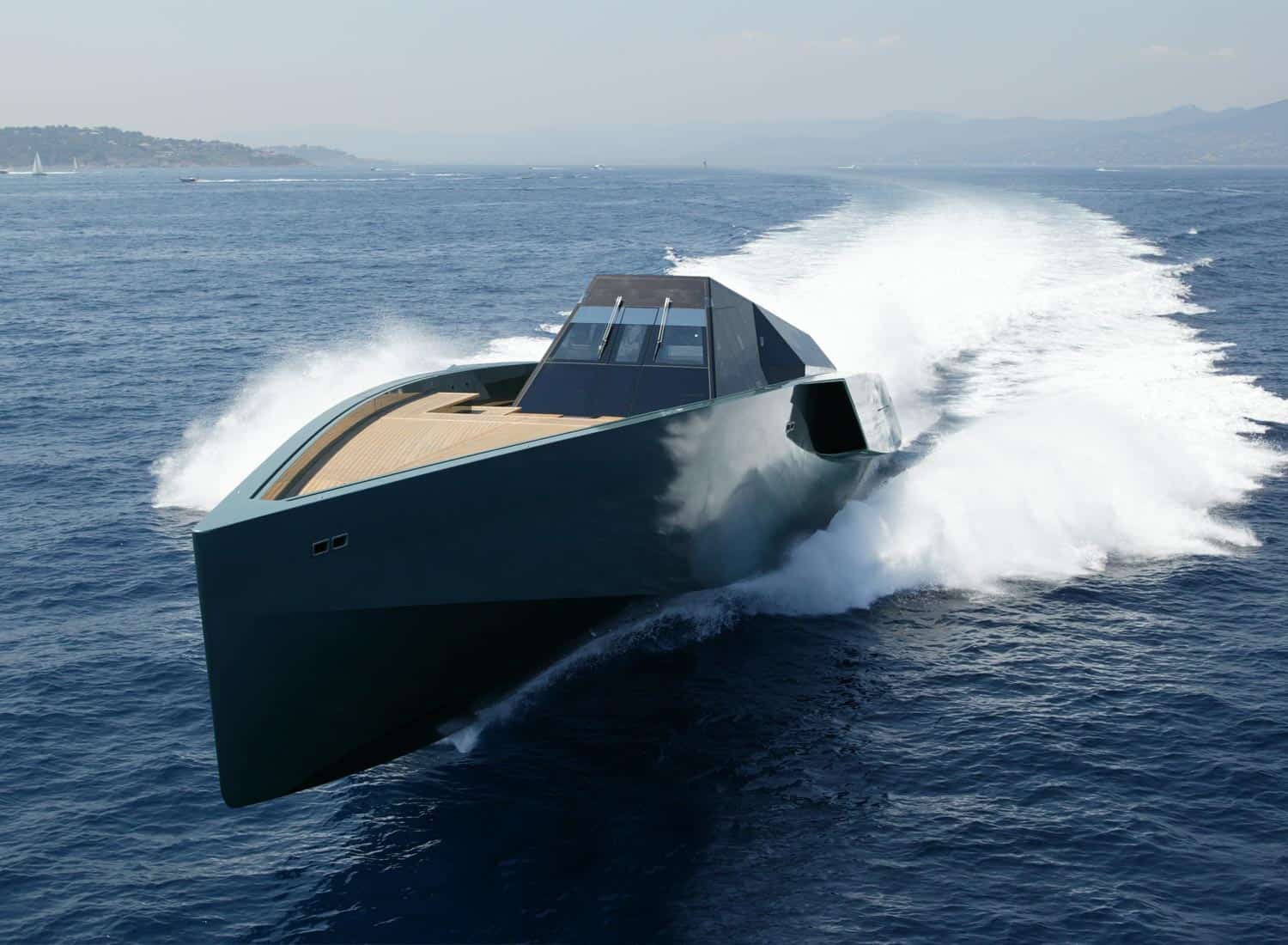
Yachts were always associated with leisure, comfort, and luxury, floating gently in a gorgeous location or cruising unhurried to the next, but somewhere along the way, something changed. Yachts started becoming faster and more powerful, and their owners more obsessed with these characteristics than anything else. But that’s the way with every kind of vehicle these days, isn’t it?
Mankind is obsessed with speed. That’s a given. And it applies to everything, including superyachts, which, despite their size, can achieve impressive speeds over water.
Whether that speed is actually needed is debatable, but one can’t ignore that there are quite a few capable yachts out there and that the competition for the fastest superyacht in the world is a fierce one, as in everything that involves the man’s thirst for speed.
The following superyachts manage to blend both the need for speed and the craving for luxury. But these are above everything else, the fastest yachts in the world right now.
Let’s have a look.
- 20. Cara Montana – 45 knots
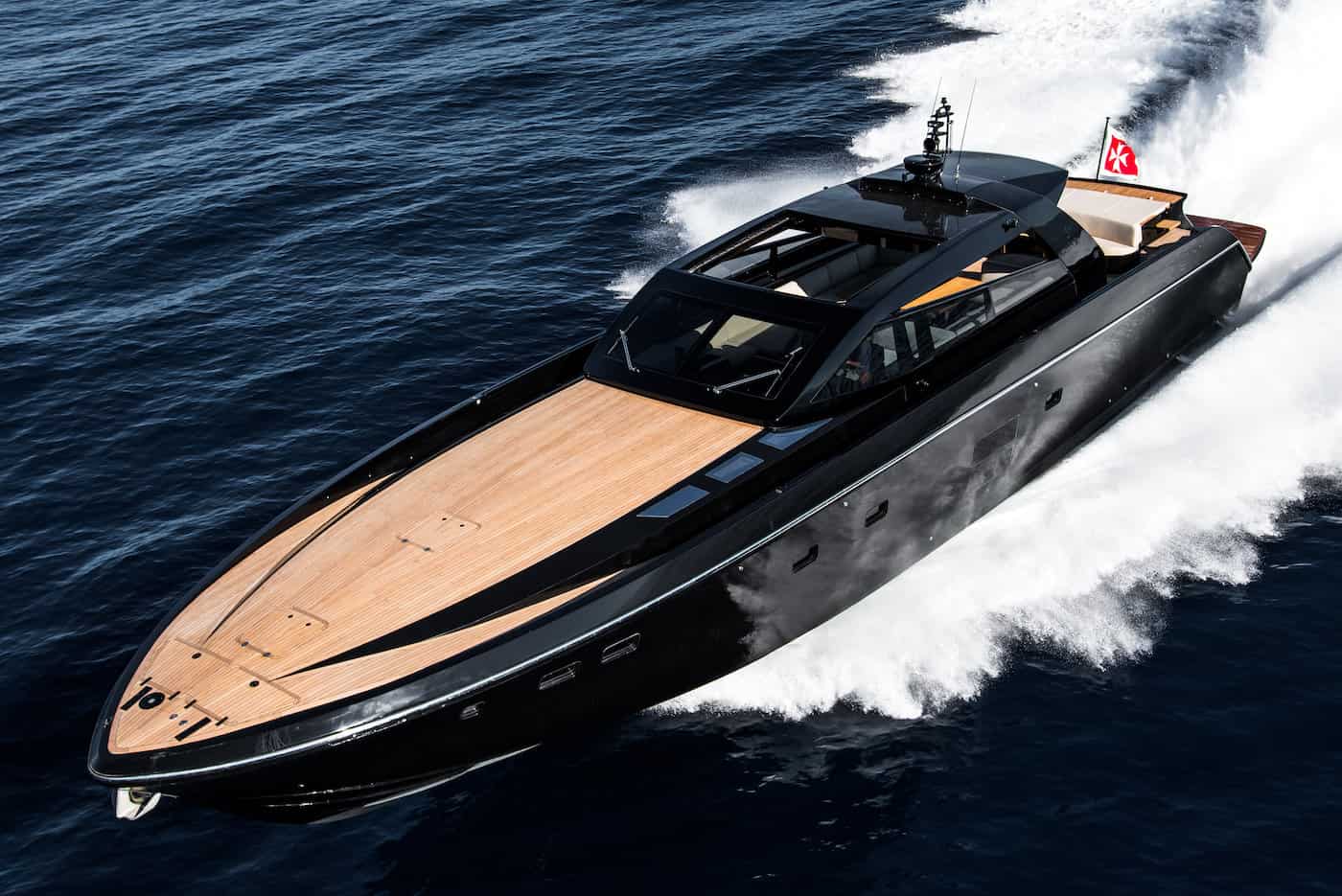
Cara Montana is a smaller yacht, manufactured in 2019 by a shipyard based in Genoa, called Otam. It’s a gorgeous maritime vehicle which spans only 25.9 meters in length, but is beautiful and powerful enough to impress.
Powered by twin MTU engines, outputting a total of 5,200 hp together, and equipped with twin surface drives, Cara Montana is able to reach a top speed of 45 knots, or just under 52 mph.
- 19. Alamshar – 45 knots

Completed in 2014 after a waiting time of 13 years spent in the manufacturing process, the Alamshar yacht can reach 45 knots, thanks to its twin Rolls-Royce Marine engines and three waterjets.
The naval architecture of the vessel was made by Donald L. Blount & Associates, the exterior design by Pininfarina, and the interior by Redman Whiteley Dixon. The whole project was put together by the Devonport shipyard in Falmouth, United Kingdom.
The Alamshar is 50 meter long, and costed a jaw dropping $200 million, paid by Aga Khan IV, for whom the custom yacht was made.
- 18. Moon Goddess – 45 knots
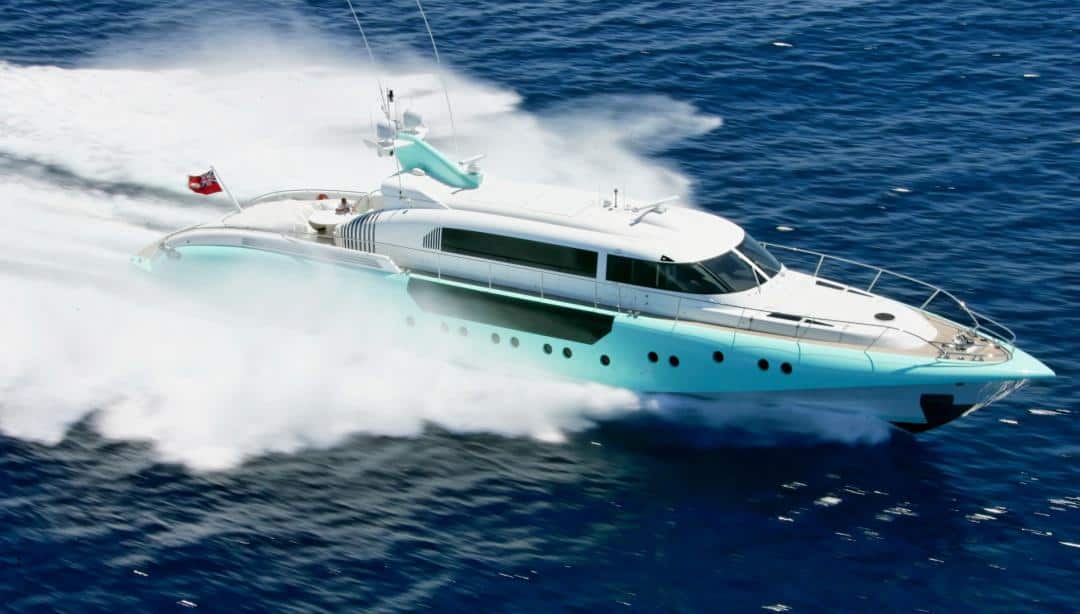
Another lovely vessel from the superyacht world is the Moon Goddess. It’s on the smaller size, being only 35 meter long, but it’s capable of reaching 45 knots. The ship was built by Danish Yachts, with the naval architecture and exterior designs made by Espen Øino, a superyacht design icon.
The Moon Goddess can take up to six guests in three posh cabins, two twins and one for the owner, plus a crew of five. It’s propelled to a cruise speed of 25 knots, or the maximum of 45, by twin MTU 16V 4000 M90 diesel engines which generate a combined 7,498 hp.
- 17. Shergar – 45 knots

The acclaimed German shipyard Lürssen built Shergar in 1983 to be among the fastest yachts in the world. Decades later, it still holds its own among better and more technological advanced vessels.
Equipped with two MTU 12V 396 TB83 diesel power plants, and two Allison 571-KF gas turbines, the Shergar is capable of cruising at 40 knots and reaching a top speed of 45 knots.
- 16. Seafire – 46 knots
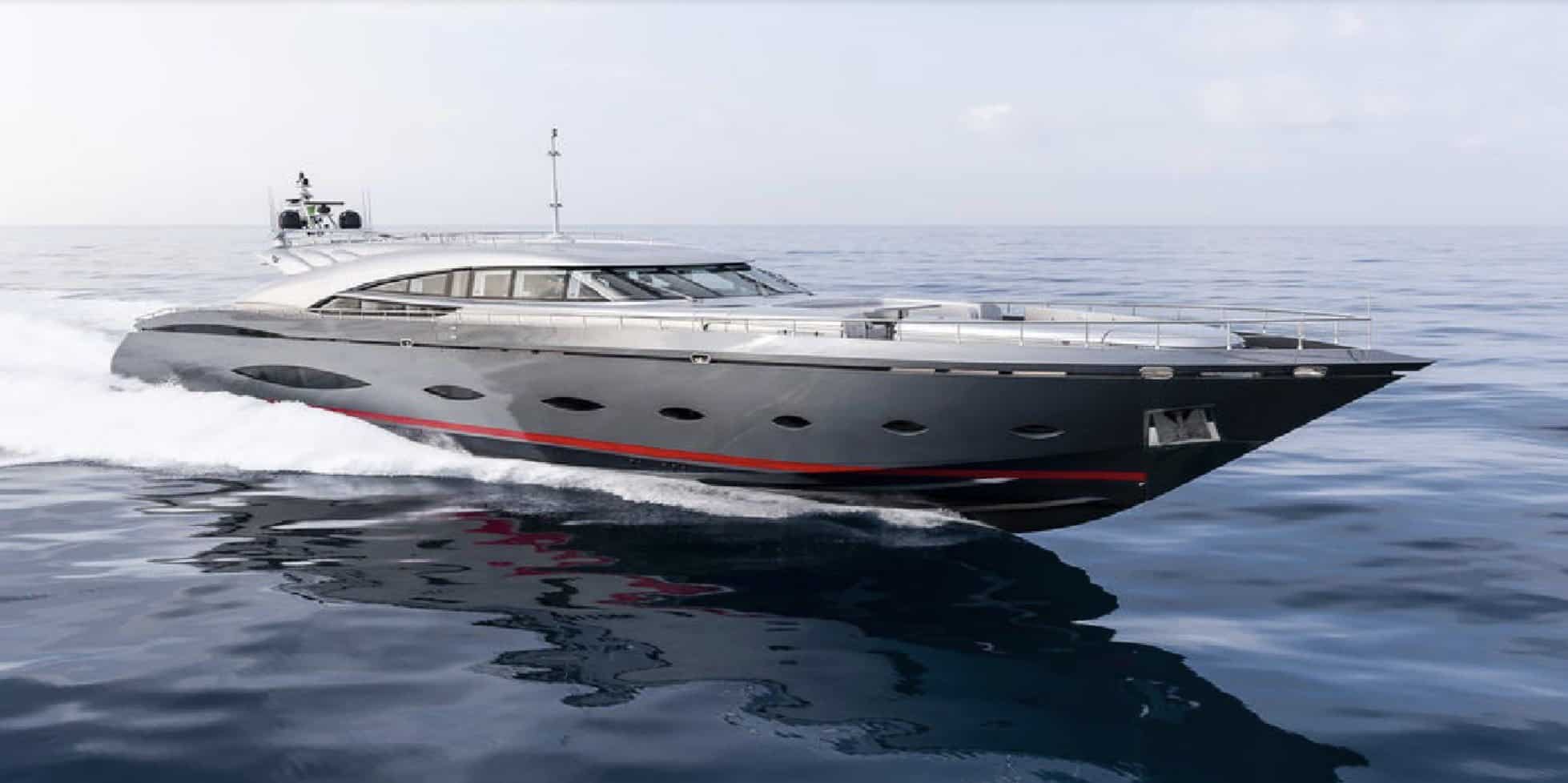
Seafire is a super yacht manufactured by AB Yachts, an Italian shipyard known for some impressive vessels. This one is among their fastest, able to reach a top speed of 46 knots.
The 42 meter super yacht is powered by a setup of three MTU 16V M94 units and three waterjets, giving it the possibility to cruise at an impressive speed of 43 knots, only 3 below its top speed.
- 15. Octopussy 007 – 53.2 knots

Built back in 1988 by the renowned Dutch shipyard Heesen Yachts and carrying a little of James Bond in its name, the Octopussy 007 is a 43.5 meter super yacht that can accommodate up to 10 guests and 7 crew members.
The vessel is powered by three MTU diesel engines that deliver 10,440 hp together, propelling the Octopussy forward at a cruising speed of 25 knots and a top speed of 53.2 knots.
It was on display at multiple boat shows around the world, and it changed owners for the last time in 2021. The naval architecture was done by Mulder Design, the exterior by Gerhard Gilgenast, and the interior by Art Line and Joachim Kinder Yacht Design.
Inside, it comes with 5 posh and extremely comfortable guest cabins, 1 master, 1 twin, and 3 double.
- 14. Daloli – 54 knots
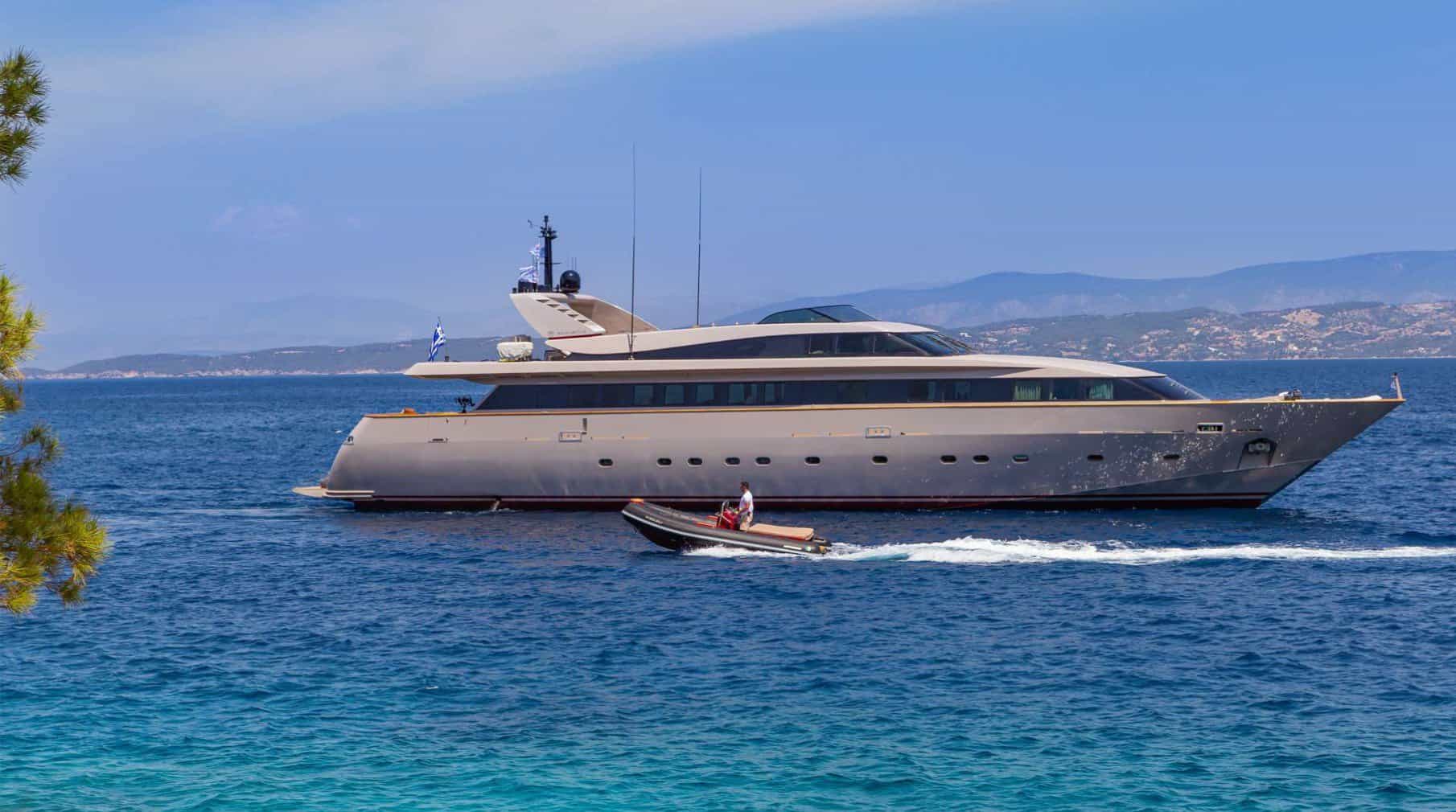
The Daloli, also known as Pandion, built by Heesen Yachts, is a 36.5 vessel that enters the category of super yachts and impresses with a top speed of 54 knots, the equivalent of just over 62 mph.
The ship has a crew capacity of 6 and can host up to 8 passengers. There’s four cabins in total on its three decks, and the sheer beauty of its design can be seen both inside and on the outside.
It’s a real beauty, and a fast one as well.
- 13. Why Not U – 55 knots
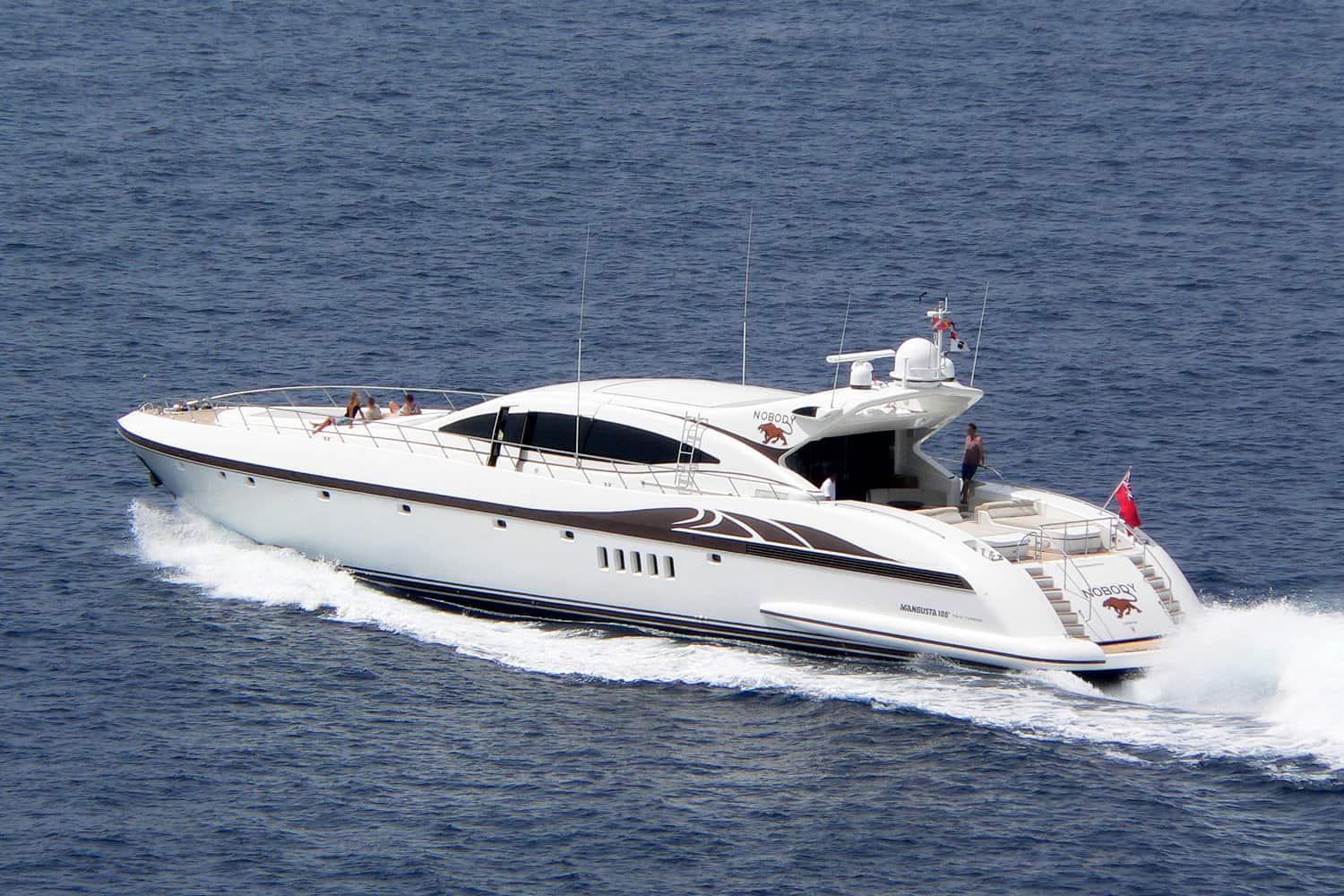
Originally named Nobody, the Why Not U was designed in 2001 by Overmarine as a deluxe super yacht that’s capable of getting his 9 guests and 3 crew to their next dream destination with a top speed of 55 knots. The power comes from a setup of Vericor TF40 gas turbine engines.
When it comes to living on it, it offers an impressive range of amenities on its teak decks. There’s several dining spots, entertainment and lounge rooms, sun bathing areas, and plenty more to be had on board of this stunning super yacht.
- 12. Ermis² – 57 knots

The 37.5 meter super yacht Ermis², manufactured from special materials by the New Zealand shipyard McMullen & Wing, is among the fastest vessels out there, capable of a top speed of 57 knots, which is just a little over 65 mph.
The ship came out in 2007, but is still among the most innovative yachts in the world given the mix of composite materials, aerospace grade carbon fiber and titanium for its lightweight body.
That low weight, combined with the 10,944 hp outputted by the three MTU 16V 4000 M90 engines, allow this stunning yacht to reach that max speed of 57 knots.
- 11. Chato – 57 knots
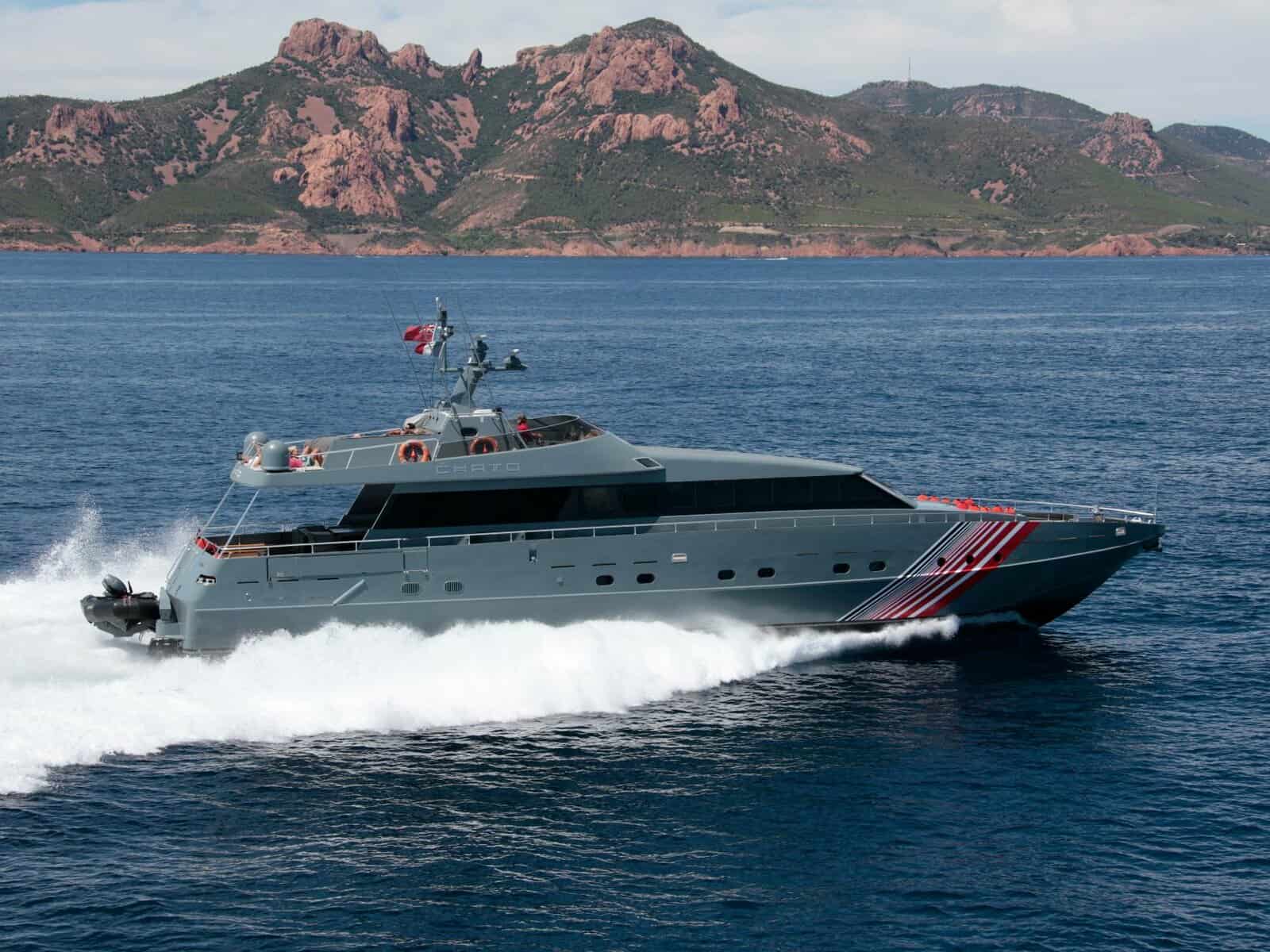
Chato is another small sized and powerful super yacht. It was built in 1986 by Baglietto from aluminium and was equipped with twin MTU 16V 396 TB94 diesel engines, which push it to a cruise speed of 35 knots and a max speed of 57 knots.
Chato is only 25.79 meters long, and that helps with a lower weight and a smaller profile under the surface of the water.
- 10. Azimut Atlantic Challenger – 60 knots
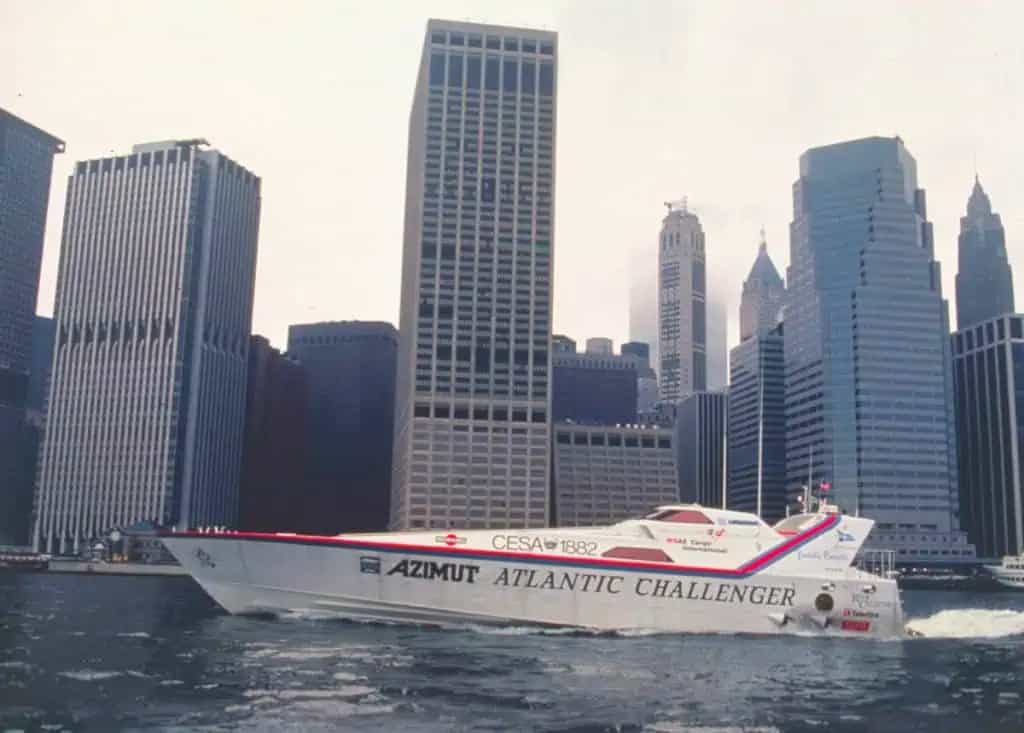
The Azimut Atlantic Challenger strays away from the usual design of luxury yachts, but that only because it was built for a very different purpose, which was to win the Blue Riband award, an unofficial accolade given to a ship for making the fastest transatlantic crossing.
Unfortunately, the Azimut Atlantic Challenger failed to win, but it remained one of the fastest super yachts in the world, currently holding the 10th position, with a top speed of 60 knots.
It was built in 1988 by the Italian shipyard Benetti, with the exterior designed by Pininfarina. It’s a 26.82 meter aluminum monohull vessel and is powered by four CRM diesel engines, capable of outputting a combined 7,400 hp.
- 9. Jet Ruban Bleu – 60 knots

The French built Jet Ruban Bleu is on par with the Azimut Atlantic Challenger and two other super yachts, at least when it comes to the top speed. They can all do 60 knots.
Jet Ruban Bleu is 25 meter long, was designed by Gilles Ollier and Coste Design & Partners and created by Multiplast. It was outfitted with a single MTU engine capable of 3,500 hp alone.
- 8. Oci Ciornie – 60 Knots
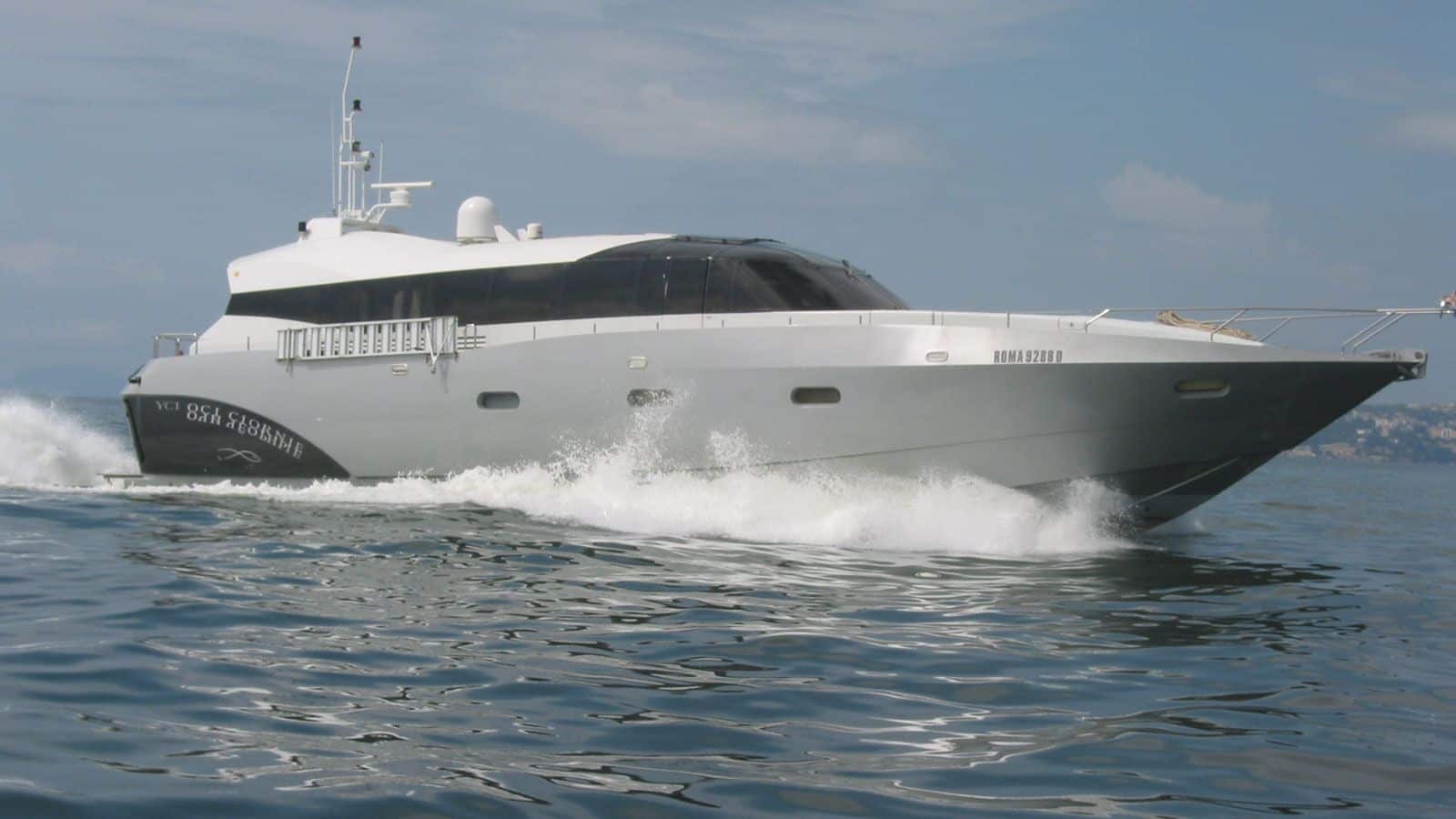
Oci Ciornie was a super yacht project that was realized by American shipyard Palmer Johnson, the Dutch Vripack, and the well known naval architect Don Shead in 1998.
The vessel features an aluminum hull, and uses two 1,800 hp MTU 16V 2000 M90 engines, a 4,600 hp AVCO Lycoming gas turbine, plus Arneson surface drives. This combination propels the Oci Ciornie with a top speed of 60 knots.
The ship is able to carry up to eight guests in a master suite, a double cabin, and a twin room. There’s a nice and streamlined deck that features a superb saloon and outside areas for relaxation, while the interior takes inspiration from aircraft designs.
- 7. Brave Challenger – 60 Knots
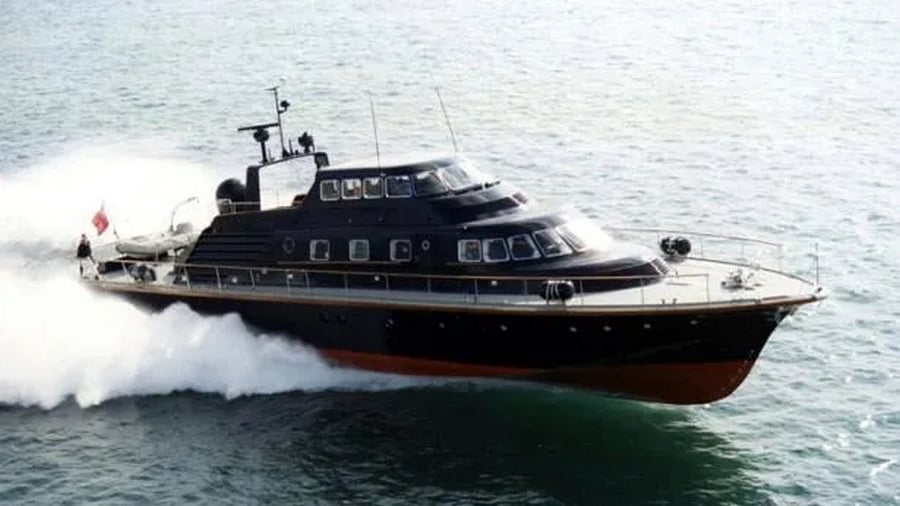
With the same 60 knot top speed of the above ships, the Brave Challenger is to be lauded, since it’s much older, being built back in 1960. The project was completed by Vosper Ltd in Portsmouth, United Kingdom, with the intention of becoming a Brave Class fast patrol boat. It was only later that the ship was converted for private use.
The Brave Challenger is powered by three Rolls-Royce Proteus gas turbines, which output a total of 13,500 hp, which combined with the only 31 meter length and lower weight, can push the boat to the top speed of 60 knots.
- 6. Kereon – 62.3 Knots

The Italian yard AB Yachts, the one behind Seafire above at number 16, built in 2004 one of the fastest super yachts in the world, the Kereon. It’s capable of hitting a top speed of 62.3 knots, and that thanks to the three CRM diesel engines that produce a good 6,300 hp.
Since the total power is so low in comparison to others on this list, it makes sense that a shorter length of 27 meters and a performant hull design are at play to aid in reaching those speeds.
The ship has a very sporty aesthetic, all metallic silver, and can cruise at 50 knots for about 900 miles.
- 5. Gentry Eagle – 63.5 knots

Gentry Eagle was a special project done by Vosper Thornycroft in 1988 for the legendary Tom Gentry, who achieved almost everything he could achieve in terms of powerboat speed records during his lifetime, including the coveted Blue Riband. The vessel, capable of 63.5 knots, helped him win the Blue Riband in 1989, with a record time of 62 hours and 7 minutes.
Gentry Eagle’s design was done by Grant Robinson and Peter Birkett, with the interior by Robin Rose. In 1992, the ship became a private super yacht.
- 4. Galeocerdo – 65 Knots

Galeocerdo is a very futuristic looking ship, with sleek lines and a hull designed to maintain high speeds in rough sea conditions. It measures 36 meters in length, and is capable of hitting 65 knots.
The vessel was built in 2003 in Italy, by Rodriguez Yachts and is powered by three Vericor TF50 gas turbines, each tied to a Rolls-Royce Kamewa water jet. The total power output rises to a whooping 16,800 hp.
- 3. Destriero – 66 knots
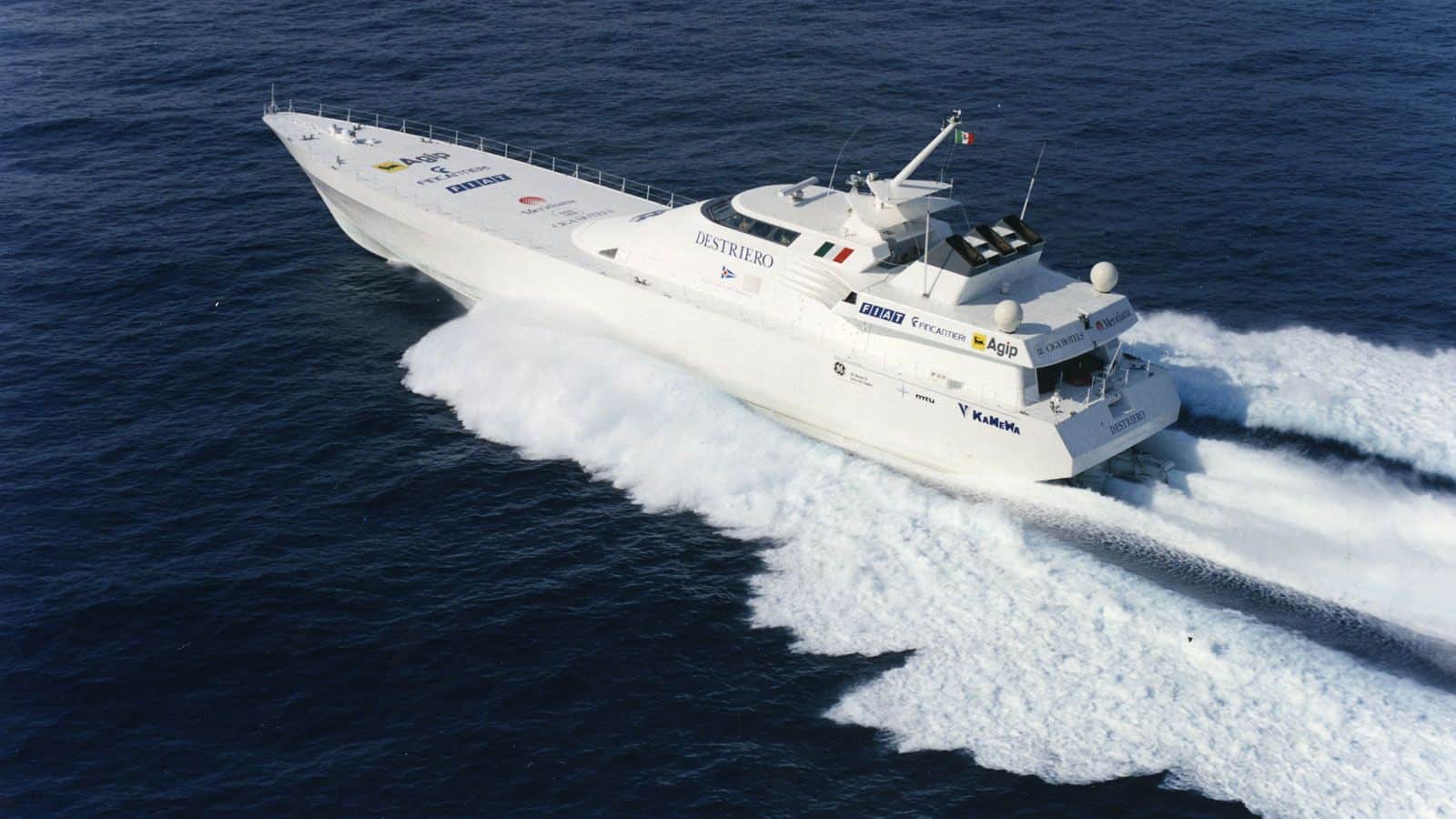
Destriero was launched back in 1991 by the Italian shipyard Fincantieri. It has a length of 68.18 meters and features a design made by Pininfarina and Donald Blount. This ship was again built with the sole purpose of winning the Blue Riband by breaking the old record of crossing the Atlantic.
She did it in 1992, after it crossed the ocean twice without refueling, setting a new record of 58 hours, 34 minutes, and 5 seconds. but the Blue Riband award was denied for her, since it’s awarded only to passenger vessels and not private yachts.
What allowed Destriero to set a new record was the power of 54,000 hp, given by the Codag engine and the three GE Aviation LM1600 gas turbines, pushing the ship to a max speed of 66 knots, or 76 mph.
- 2. World Is Not Enough – 67 Knots
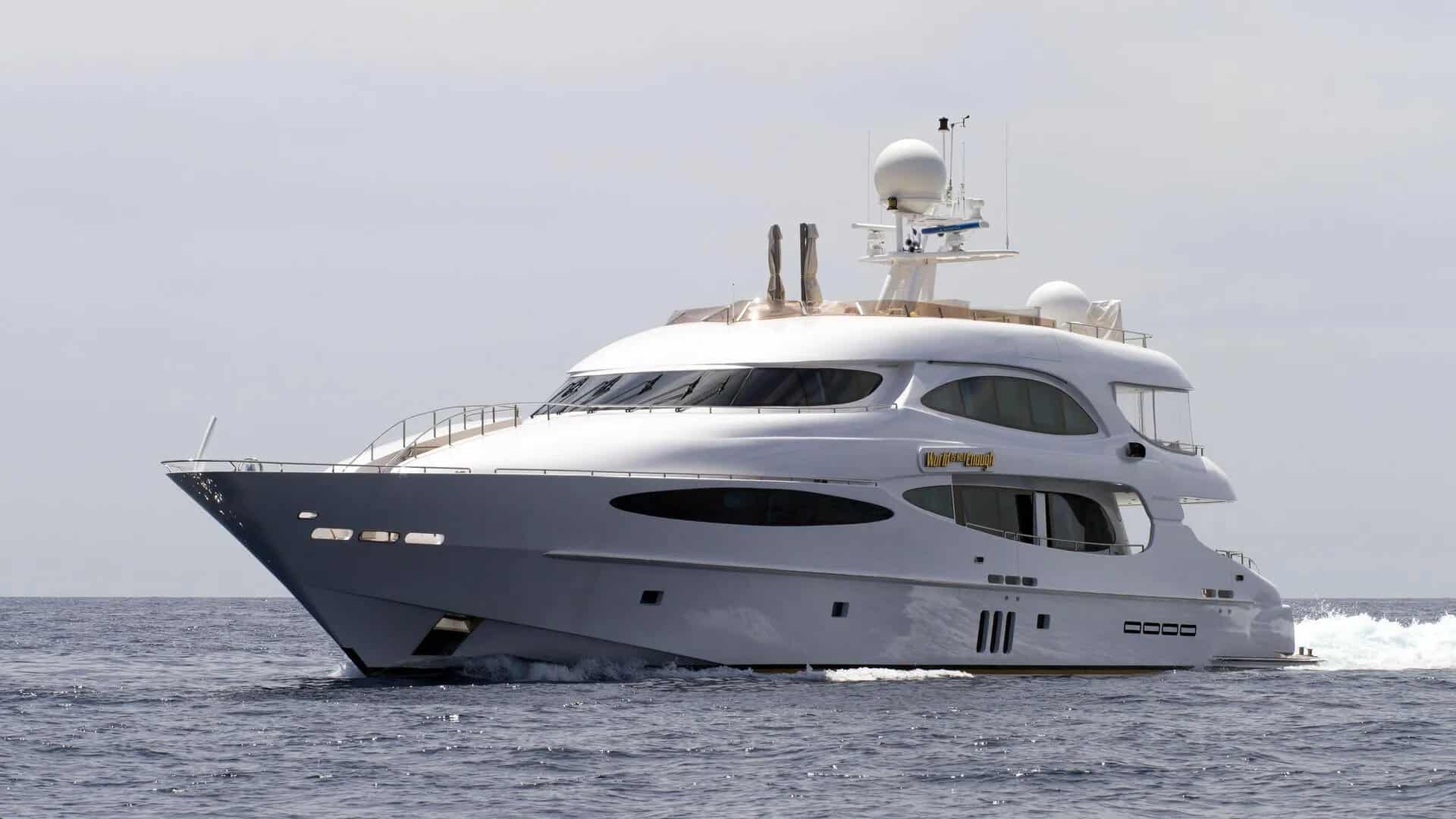
The Dutch superyacht World Is Not Enough, built in 2004 by Millenium Super Yachts, comes second place with a top speed of 67 knots. The vessel is powered by two Paxman diesel engines and two Lycoming gas turbines, which give an output of 20,600 hp, and a good 3800 nautical miles cruising range at a cruising speed of 10 knots.
With its 42.4 meters of luxury and beauty, World Is Not Enough can accommodate up to 10 guests and 7 crew members in five extravagant cabins, offering plenty of comfort and areas for relaxation. The vessel features formal dining spaces, indoor bar, and al fresco dining and lounge areas on all decks, for the ultimate pleasure away from civilization.
- 1. Foners – 70.1 knots
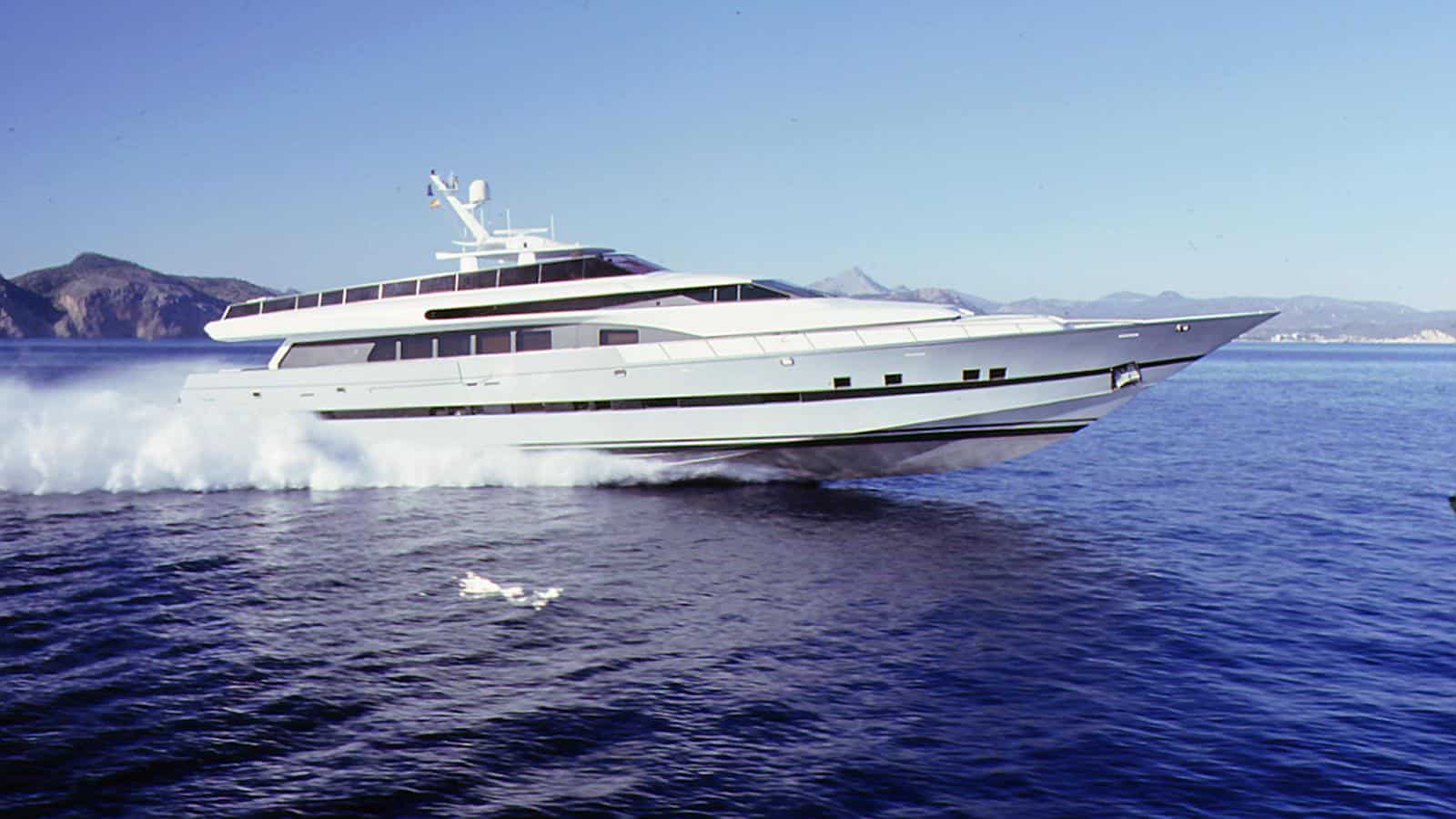
The Foners is currently the fastest super yacht in the world, with a 70.1 knots top speed, keeping the first spot since its delivery back in 2000. The power behind its top speed comes from two MAN engines and three Rolls Royce gas turbines, combining together to output a whooping 21,380 hp.
Her cruising speed is 12 knots, and allows her to reach a range of 1,800 nautical miles.
But of course speed isn’t everything here, as the eye is impressed a lot when stepping on board. Built by the Spanish shipyard Izar, Foners comes with splendid interiors, formal dining rooms, and plenty of space on the decks for al fresco dining. Its 6 crew and up to 8 guests can be accommodated on board, in luxurious cabins.
These are the fastest super yachts in the world, a competition that keeps on going, dominated for the last two decades by the Spanish vessel Foners.
As technology progresses, it will be interesting to see how it holds up against newer yachts.

About Alex Holmes
With over 10 years of experience in media and publishing, Alex is Luxatic's director of content, overlooking everything related to reviews, special features, buying guides, news briefs and pretty much all the other content that can be found on our website. Learn more about Luxatic's Editorial Process .
2 thoughts on “The 20 Fastest SuperYachts in the World”
Bolide by VICTORY DESIGN is now by far the fastest yacht; speeds up to 76 knots have been recorded by this 80ft full carbon pleasure Yacht, powered by three MAN V12 2000 diesel engines.
Leave a Comment
More from luxatic.
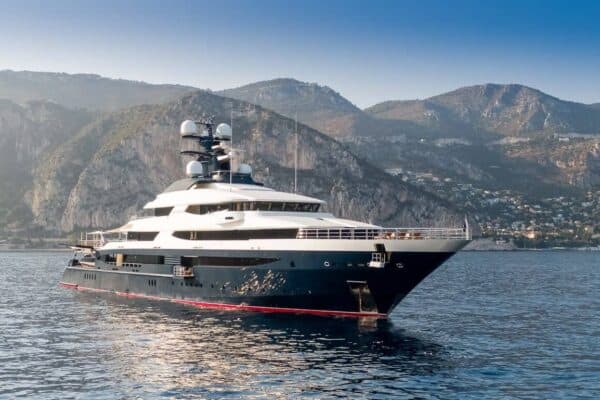
20 Largest Explorer Yachts in the World
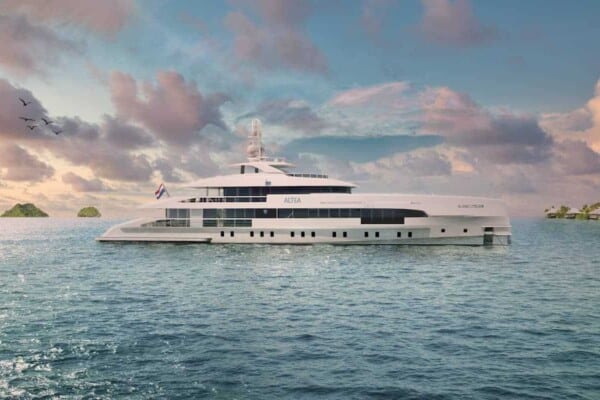
Best Luxury Yacht Brands: 25 Shipyards Which Build The Best Superyachts
By Brody Patterson
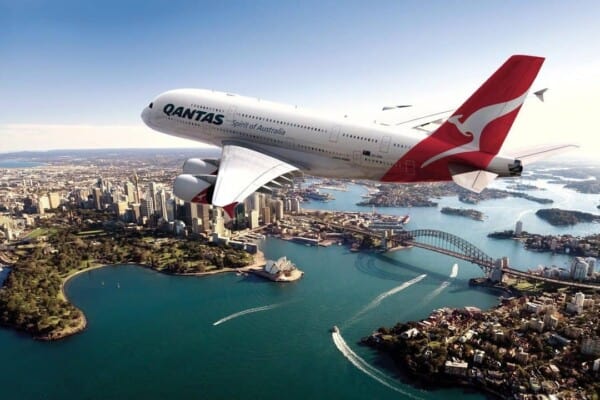
The 20 Best Airlines in the World Right Now
By Adrian Prisca

The Longest & Shortest Runways in the World!
By Vlad Craciun
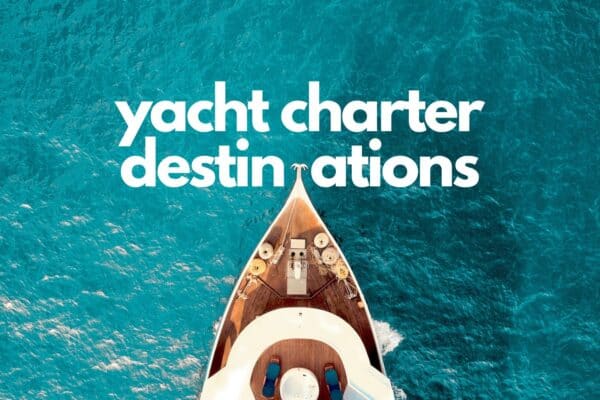
Sailing in Style: The World’s Most Beautiful Yacht Charter Destinations

These are The 15 Fastest Planes of All Time
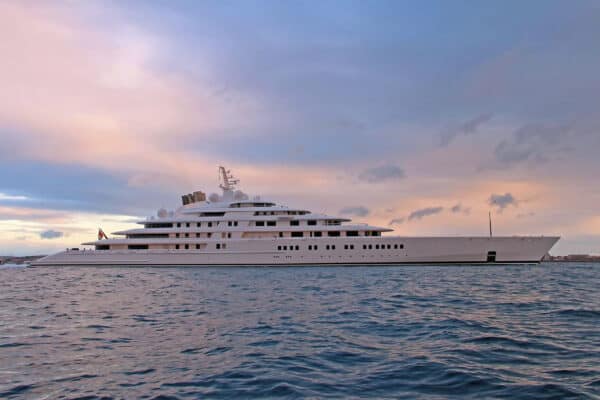
These Are The 25 Biggest Yachts in the World!
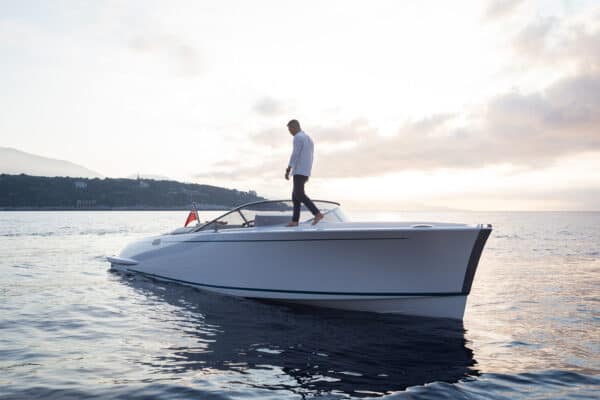
20 Best Electric Motorboats You Will Surely Love

The 15 Best Small Planes That You Can Buy Right Now

The 15 Biggest Planes in the World

The 15 Best Personal Submarines For Superyacht Owners
By Victor Baker

The 10 Longest Range Private Jets in the World in 2023

Find anything, super fast.
- Destinations
- Documentaries
Superyachts For Sale
509 luxury yachts for sale from around the world
Featured Yachts
Royal Denship
- LENGTH 44.0m
Tranquility
- LENGTH 91.5m
- LENGTH 108.0m
Mitsubishi Heavy Industries
- LENGTH 82.6m
Featured events
Mega & Superyachts for Sale
983 Superyachts for Sale Worldwide
Northrop & Johnson is proud to offer an extensive, global and all-encompassing selection of superyachts for sale. The superyacht sector comprises the world’s most luxurious, well-designed, top-performing yachts with a wide range of amenities and styles. We hope you find your dream yacht below. When you do, please contact a Northrop & Johnson sales broker to begin the buying process.
To search by Price Range please select a preferred currency above.
Listed by N&J
Sorry, there were no results found for your search.
Which Superyacht is Right for You?
The type of superyachts best suited for you depends on the on-water experience you want. You may want power and speed, ensuring a motor-powered superyacht is right for you. Alternatively, you may want to feel the wind pushing you across the water, so a sailing yacht is best suited for your needs. In either respect, the most popular superyachts feature incredible amenities, top performance and exceptional design that allows them to retain their value for resale or charter.
When choosing the ideal superyacht, you – with the help of your broker – will weigh various options and features, including style, type of yacht, build pedigree, crew layout, facilities, décor and more. Whether you are looking for a large, modern motor yacht or a classically styled gentlemen’s yacht, Northrop & Johnson has a wide selection of superyacht types available for sale.
When buying or building a yacht, remember: first and foremost, your yacht is for you and your family or friends to use. What type of experience and use are you looking for in your ownership? Are you interested in a new or used yacht? Custom built or semi-custom? How are you planning to use your yacht? If you are planning to charter your yacht to help offset some of the running costs, then factor in the charterer, but remember, a yacht is very personal and you must consider your own needs as a priority.
Types of Superyachts
The type of yacht will shape the experience for the owner. The most popular superyachts (be they sail or motor) have a combination of elements that make them strong across the board both during ownership and in resale value and charter success. From the style and type of yacht and the build pedigree to the crew layout, the facilities and even the décor, there are many factors that, when combined, influence the enjoyment of yacht ownership. Whether you are looking for a large, modern motor yacht or a classically styled gentlemen’s yacht, Northrop & Johnson has a wide selection of superyacht types available for sale. When buying or building a yacht, remember that first and foremost your yacht is for you and your family or friends to use. What type of experience and use are you looking for in your ownership? Are you interested in a new or used yacht? Custom built or semi-custom? How are you planning to use your yacht? If you are planning to charter your yacht to help offset some of the running costs then factor in the charterer, but remember, a yacht is very personal and it is important that you think of your own needs as a priority.
Proud to be part of the MarineMax family
© 2024 Northrop & Johnson

The global authority in superyachting
- NEWSLETTERS
- Yachts Home
- The Superyacht Directory
- Yacht Reports
- Brokerage News
- The largest yachts in the world
- The Register
- Yacht Advice
- Yacht Design
- 12m to 24m yachts
- Monaco Yacht Show
- Builder Directory
- Designer Directory
- Interior Design Directory
- Naval Architect Directory
- Yachts for sale home
- Motor yachts
- Sailing yachts
- Explorer yachts
- Classic yachts
- Sale Broker Directory
- Charter Home
- Yachts for Charter
- Charter Destinations
- Charter Broker Directory
- Destinations Home
- Mediterranean
- South Pacific
- Rest of the World
- Boat Life Home
- Owners' Experiences
- Interiors Suppliers
- Owners' Club
- Captains' Club
- BOAT Showcase
- Boat Presents
- Events Home
- World Superyacht Awards
- Superyacht Design Festival
- Design and Innovation Awards
- Young Designer of the Year Award
- Artistry and Craft Awards
- Explorer Yachts Summit
- Ocean Talks
- The Ocean Awards
- BOAT Connect
- Between the bays
- Golf Invitational
- Boat Pro Home
- Pricing Plan
- Superyacht Insight
- Product Features
- Premium Content
- Testimonials
- Global Order Book
- Tenders & Equipment
Yachts for Sale
For aspiring yacht owners looking for a luxury yacht for sale, we have put together a fine selection of luxury yachts and megayachts for sale from all over the world. Search BOAT International's collection of superyachts for sale and filter by type, length, asking price or age. Narrow the results by selecting specific features, or browse by speed, designer and much more.
Explore luxury yachts for sale
Search for everything from motor yachts for sale from renowned Dutch yards including Feadship and Heesen , premium Italian names including Azimut , Sanlorenzo and Benetti , popular British builders Sunseeker and Princess , and American megayachts for sale from US yards such as Westport .
Our collection also features sailing yachts for sale from legendary names such as Royal Huisman , Perini Navi , Nautor's Swan and Jongert , as well as some of the most well-known explorer yachts for sale .
Yacht Features
Propulsion System
Palm Beach International Boat Show returns to West Palm Beach waterfront
The Palm Beach International Boat Show returns this week with more nearly 1,000 vessels on display, including super yachts from around the world.
Tickets are on sale now for the show that runs March 21-24 along the West Palm Beach waterfront.
The show, which started in 1982, has grown to a major economic engine for the community, with last year's impact estimated at $1.05 billion statewide — nearly as much as the $1.3 billion Miami International Boat Show, said Alyssa Freeman, executive director of the Marine Industries Association of Palm Beach County, which owns the boat show.
More: Cool front for South Florida won't be its last even with the first day of spring here
"Palm Beach is really not that far behind Miami, and Miami is the biggest in the world," Freeman said. "That was really exciting."
This year's boat show features an expanded Super Yacht Show at Palm Harbor Marina, showcasing yachts that typically stretch longer than 80 feet and have a variety of luxurious amenities that include hot tubs, crew quarters, dance floors and sun decks.
"We have more super yachts there than we ever have before, and they're even bigger," Freeman said, noting that at 236 feet, the vessel Casino Royale takes the title of largest yacht at this year's show. The title of "most expensive yacht" goes to Come Together, a 196-foot vessel priced at $59.95 million.
"Everybody, when they think about super yachts, they think about Monaco and Miami, but Palm Beach is a real player in these boat shows and the yachting world," Freeman said.
Exhibitors continue to be drawn to the Palm Beach International Boat Show by the opportunity for high sales year after year when compared with other South Florida boat shows, she said.
"I've heard from several of them, this is their favorite show to attend," Freeman said, "And that's why, because their sales are higher at Palm Beach."
The show continues to make headway in improving its sustainability efforts, she said. After reducing single-use plastics, a major change this year is the addition of water bottle refilling stations throughout the show, Freeman said.
"I think that's exciting because everybody's talking about sustainability and how we can be more sustainable," she said. "Every year, we take little steps to be more sustainable."
Freeman said she is excited for this year's AquaZone presented by Nautical Ventures. The attraction showcases some of the "yacht toys" that are new or popular on the market.
"It's so cool, because there are people actually in the water demoing yacht toys, and it's usually the latest and greatest," she said. "There's always something new every year that we've never seen before."
The Palm Beach International Boat Show also features a range of seminars, demonstrations and discussions throughout the weekend, including mental health in yachting, tips to boat to the Bahamas, safe boating to protect sea turtles and how to address active threats and piracy.
Freeman, who has children, said she loves the Kids Fishing Clinics scheduled for noon and 2 p.m. Saturday and Sunday with captain Don Dingman.
"Captain Don has been doing this for years, and he does a fantastic job," Freeman said. "The kids actually get to go home with a free rod and reel once the clinic is over."
The association produces the Palm Beach International Boat Show with Informa Markets' U.S. Boat Shows division.
"As we gear up for the 2024 Palm Beach International Boat Show, we are excited for our return to Downtown West Palm Beach to celebrate the rich history of this esteemed event," Andrew Doole, president of U.S. Boat Shows at Informa Markets, said in a news release. "Each year, we’re grateful for the warm welcome and support from the community, which truly makes this event a highlight on the calendar for both residents and visitors alike."
Informa also produces the Palm Beach Modern + Contemporary art show happening March 21-24, at the Palm Beach County Convention Center. A Windward VIP ticket to the boat show includes admission to the art show as well.
In addition to serving as a cornerstone festival of spring in West Palm Beach, the boat show launched the Palm Beach International Boat Show Gives Back program to provide hundreds of thousands of dollars in contributions to local nonprofits, Freeman said.
The grant program had a soft launch last year and formalized the boat show's four-decade practice of giving back to the community, Freeman said.
"We're really excited about it," said Freeman, who added that the boat show team is working with the Community Foundation to manage the grant program, which they hope to grow. "That's something that's a super high priority for us."
Money raised through a portion of the boat show's ticket sales, optional add-ons and some related activities goes toward the fund.
The boat show in February announced that the first round of grants totaling $500,000 would go to 25 nonprofits that have marine-related programs or projects, including Florida Fishing Academy, Loggerhead Marinelife Center, Florida Atlantic University, Inlet Grove High School, Palm Beach State College, Sea Turtle Adventures and Friends of Manatee Lagoon.
"We're hoping one day we'll be able to say that it's a million dollars," she said. "So fingers crossed. It relies on the success of the boat show and the support of the community. With that, we will continue to grow."
What: Palm Beach International Boat Show.
When: Noon to 7 p.m. March 21, 10 a.m. to 7 p.m. March 22 and 23, 10 a.m. to 5 p.m. March 24.
Where: West Palm Beach waterfront.
Cost: General admission is free for ages 6 and younger with purchase of an adult ticket, $17 for a one-day ticket for ages 6-15, $33 for a one-day ticket for ages 16 and older, and $60 for a two-day adult ticket. VIP experiences start at $390 for a Windward single-day ticket.
Information: pbboatshow.com
Kristina Webb is a reporter for Palm Beach Daily News, part of the USA TODAY Florida Network. You can reach her at [email protected] . Subscribe today to support our journalism.
The superyacht world is speculating that Mark Zuckerberg just bought this 118-meter boat
- The 118-meter superyacht Launchpad made her maiden voyage last week.
- The yacht world is speculating that her owner is Meta CEO Mark Zuckerberg.
- Here's what we know about the luxury vessel.

In the world of superyachts , privacy is the most valuable asset. It can be next to impossible to discern the details of a superyacht transaction — and that's particularly true if the vessel in question is worth nine figures.
Yet some in the boat blogging world are speculating that Meta CEO Mark Zuckerberg is the new owner of Launchpad, a megayacht currently moored in Fort Lauderdale, Florida after she made her maiden voyage from Gibraltar to St Maarten last week. Launchpad clocks in at 118 meters long, about nine meters shorter than Jeff Bezos' superyacht Koru .
The transaction could not be confirmed, with yacht world insiders declining to share what they know and representatives for Zuckerberg not responding to a request for comment from Business Insider. In the past, reports about Zuckerberg owning superyacht Ulysses have proven false.
Related stories
"It is Feadship's standard policy to never divulge any information about our yachts with reference to ownership, costs, or delivery, etc," Feadship, the ship's builder, wrote to BI. "Whether it is an 18-meter Feadship from the 1960s or a 118-meter Feadship from the 21st century, we do not share private information."
But Zuckerberg's name has been connected to Launchpad for a few months now, beginning in December when reports swirled that he visited Feadship's shipyard in the Netherlands.
Then, earlier in March, yachting bloggers like eSysman SuperYachts and Autoevolution started speculating that he officially snagged the boat, originally built for a sanctioned Russian businessman, at a $300 million price tag. (While that's a seemingly huge amount, it's still less than 0.2% of Zuckerberg's $177 billion net worth.)
Another clue that might point to US ownership is that the yacht bears the flag of the Marshall Islands, a US territory and commonplace for American buyers to register their ships, according to public marine tracking.
If Zuckerberg were to have bought Launchpad, he would join a cohort of superyacht-owning tech billionaires . Along with Bezos, the likes of Oracle cofounder Larry Ellison and Google cofounders Sergey Brin and Larry Page have purchased impressive boats with even more impressive amenities.
SuperYacht Times , an industry publication and intelligence platform, has some of the best images of the yacht. Photos show a swimming pool on her main deck and a large helipad.
While less is known of the interior, a vessel of her size can likely sleep dozens of guests and crew and may have amenities like an expansive gym where Zuckerberg could practice his jiu-jitsu or a spa with a massage area. We suspect there's also space for plenty of toys — which could include his viral hydrofoil foil .
Do you have any details about Launchpad or any other superyachts? Email reporter Madeline Berg at [email protected].
Watch: Walmart heiress' superyacht vandalized by activists in Ibiza
- Main content

Endorsements | Keeping up with the Bezoses: Mark Zuckerberg…
Share this:.
- Click to share on Facebook (Opens in new window)
- Click to share on Twitter (Opens in new window)
- Click to print (Opens in new window)
- Click to email a link to a friend (Opens in new window)
Today's e-Edition
- Opinion Columnists
Endorsements
Endorsements | keeping up with the bezoses: mark zuckerberg buys a super yacht, reports say, a report says that zuckerberg’s luxurious new $300 million vessel was originally was commissioned by a russian oligarch who was the target of sanctions imposed after that country’s invasion of ukraine.

Given that Mark Zuckerberg enjoys a respectable 16th place on a list of the world’s richest people, he probably figured it was time for him to acquire one of the ultimate status symbols for the mega-wealthy — a super yacht.
A new report from The Sun said that Zuckerberg is now the proud owner of a $300 million vessel that he has christened “Launchpad.” The 387-foot-long vessel, which comes with a helipad and a $30 million companion boat, was seen docked this week at Port Everglades in Fort Lauderdale, Florida, with its unique chrome finish reflecting in the sun.
This purchase shows, among other things, that the Facebook and Meta founder and CEO has branched out from buying islands and building an underground complex to help him survive the apocalypse. Perhaps, he wants to cruise the Mediterranean this summer and be among the moguls who can play host to Leonardo DiCaprio.

The yacht definitely grants him admission to the watery playgrounds of such multibillionaires as Jeff Bezos, Larry Ellison, Bill Gates and any of the Russian oligarchs who haven’t been the target of sanctions imposed by the United States or its allies over Russia’s 2022 invasion of Ukraine.
In fact, Zuckerberg reportedly came by Launchpad due to the misfortunes of one of those oligarchs. The yacht originally was commissioned to be built by Vladimir Potanin, one of Russia’s richest men who is on multiple sanctions list, according to a report by Autoevolution.com , a transportation industry site. The yacht was known as Project 1010, and the shipbuilder in the Netherlands was legally barred from delivering it to Potanin when it was completed in 2022, though Autoevolution also said that Potanin was not the yacht’s actual owner.
The Sun reported that the yacht recently received “special permission” to be imported. It has since arrived in the United States, a couple months ahead of Zuckerberg’s 40th birthday on May 14 — which raises the question of whether he meant Launchpad as a birthday gift to himself.
It’s quite a gift: Launchpad can comfortably fit 24 guests aboard. It also requires a crew of 48 and is said to cost $30 million a year for upkeep and usage, according to Superyachtfan.com . But shelling out $30 million for maintenance a year shouldn’t be a problem for Zuckerberg, who reportedly earns between $6 million and $12 million a day, The Sun said.
But as spectacular as Launchpad sounds, super yacht fans might say it’s not as spectacular as Jeff Bezos’s super yacht, Koru. The $500 million sailing vessel features very tall masts, a swimming pool, a helipad and room for a second, smaller yacht. The most noteworthy thing about Koru is that Bezos commissioned a special sculpture to decorate its prow. It’s a “curvaceous winged goddess” that is said to bear a striking resemblance to his fiancee Lauren Sanchez.
The Amazon founder, his wife-to-be and the goddess figurehead spent much of last summer sailing around the Mediterranean, cruising from Spain to Croatia and hosting such famous guests as Katy Perry, Orlando Bloom and Usher. The couple also threw a lavish engagement party off the coast of Positano on Italy’s Amalfi coast, attended by another pack of famous friends, including Kris Jenner, Wendi Murdoch and, yes, Leonardo DiCaprio.
- Report an error
- Policies and Standards
More in Endorsements

Endorsements | Our Bay Area endorsements for Tuesday’s primary election ballot

Endorsements | Editorial: Even wealthy Piedmont residents deserve honest ballot information about their taxes

Endorsements | Editorial: Ballot plan shows California school construction inequities

Endorsements | Editorial: East Bay voters should OK only one of four school bond plans
- Motorcycles
- Car of the Month
- Destinations
- Men’s Fashion
- Watch Collector
- Art & Collectibles
- Vacation Homes
- Celebrity Homes
- New Construction
- Home Design
- Electronics
- Fine Dining
- Baja Bay Club
- Costa Palmas
- Fairmont Doha
- Four Seasons Private Residences Dominican Republic at Tropicalia
- Reynolds Lake Oconee
- Scott Dunn Travel
- Wilson Audio
- 672 Wine Club
- Sports & Leisure
- Health & Wellness
- Best of the Best
- The Ultimate Gift Guide
Rossinavi Just Launched a Custom, Full-Aluminum 164-Foot Superyacht
The sleek newcomer is topped with an unusually large 1,500-square-foot sundeck., rachel cormack.
Digital Editor
Rachel Cormack's Most Recent Stories
- Jacob & Co. Just Unveiled 3 Palatial Watches With Luxe Hard-Stone Dials
Lexus Just Unveiled a Speedy New 68-Foot Yacht
- Fabergé’s Newest Bejeweled Egg Is Inspired by the James Bond Classic ‘Octopussy’
- Share This Article

Rossinavi ’s newest fleet member is big on style and space.
Related Stories
- 24 Fascinating Things You Didn’t Know About Rolls-Royce
- Genesis Just Unveiled Its First Full-Size Electric SUV Concept
- Four Seasons Just Unveiled the First Itineraries for Its Luxurious Cruise Ship

“The goal was to combine stylistic coherence with extra dimensions,” Rossinavi’s chief operating officer Federico Rossi said in a statement.
To that end, the superstructure was extended to create what is a huge sundeck for a vessel of this size. Spanning more than 1,500 square feet, the deck features an aft area for sunbathing, a shaded central lounge with a bar, and a splashy mini pool at the bow.

The sundeck isn’t the only draw outdoors, though. The upper deck provides seafarers with a spot for alfresco dining in all four seasons, with the aft covered by a nifty veranda that protects against the elements.
Heading to the aft, the unconventional deck arrangement creates pockets of space on different levels for specific functional needs. The staggered decks also allow the aft section to be perceived as a single open area, even though there are distinct sections. The main deck cockpit includes a dining area with sliding glass panels for protection against the elements and an outdoor living area. The latter leads to a beach area with foldable platforms and an openable aft hatch. The beach club itself is enclosed because sometimes you need a break from the sun.
Perhaps we should say Bel1 is big on style, space, and smooth sailing.
Rachel Cormack is a digital editor at Robb Report. She cut her teeth writing for HuffPost, Concrete Playground, and several other online publications in Australia, before moving to New York at the…
Read More On:
More marine.

This New High-Performance Electric RIB Can Hit a Ferocious 50 Knots at Full Tilt

This New 144-Foot Superyacht Has a Glassed-In Dining Room With Ocean Views

This Insane Submarine Concept Doubles as a 107-Foot Superyacht

Culinary Masters 2024
MAY 17 - 19 Join us for extraordinary meals from the nation’s brightest culinary minds.
Give the Gift of Luxury
Latest Galleries in Marine

Four Seasons Yacht in Photos

Lexus LY680 Yacht in Photos
More from our brands, h&m q1 sales dip in first results under new ceo daniel ervér, harris, blitzer launch youth sports firm unrivaled as tcg invests, cannes-bound ‘directors factory philippines’ wraps filming, africa’s leading fair 1-54 gains a foothold in asia with hong kong exhibition at christie’s, the best yoga blocks to support any practice, according to instructors.
- New Terms of Use
- New Privacy Policy
- Your Privacy Choices
- Closed Captioning Policy
Quotes displayed in real-time or delayed by at least 15 minutes. Market data provided by Factset . Powered and implemented by FactSet Digital Solutions . Legal Statement .
This material may not be published, broadcast, rewritten, or redistributed. ©2024 FOX News Network, LLC. All rights reserved. FAQ - New Privacy Policy
See Meta CEO Mark Zuckerberg's brand new 287-foot superyacht
The 287-foot yacht, called 'launchpad' cost $300m.

SEE IT: Mark Zuckerberg’s $300 million new superyacht
Billionaire Mark Zuckerberg, founder and CEO of Facebook parent Meta, gifted himself a $300 million superyacht named ‘Launchpad’ as his net worth nears $200 billion. Credit: Dutch Yachting
Mark Zuckerberg reportedly rewarded himself with a luxurious gift: a $300 million super yacht.
The billionaire Meta Platforms CEO reportedly purchased the 287-foot vessel with the name Launchpad, according to The Sun and New York Post.
FOX Business reached out to Meta Platforms and a Zuckerberg personal spokesperson for comment on the vessel.
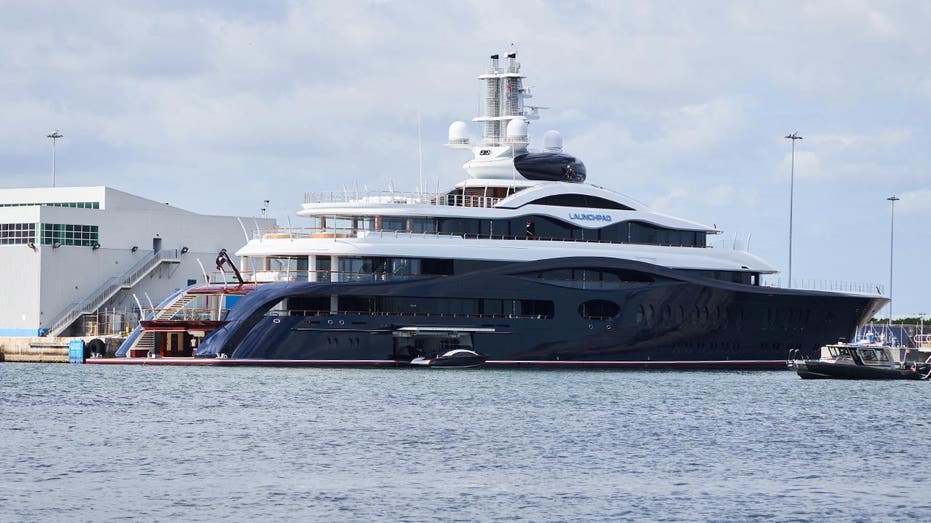
Mark Zuckerberg's 387-foot long superyacht, Launchpad, sits at Port Everglades in Fort Lauderdale, Florida, this week. (Romain Maurice/MEGA / Mega)
The vessel reached America a few days ago, cruising into Fort Lauderdale’s port in the Sunshine State, according to Business Insider. Prior to that, it had recently completed its first-ever official sailing.
MARK ZUCKERBERG RAISING CATTLE WITH DIET OF BEER AND NUTS
In photos, the dark blue-hulled Launchpad appeared to have multiple decks.
Superyacht Times pegged its gross tonnage at about 5,000. It can reportedly sail as fast as 24 knots.
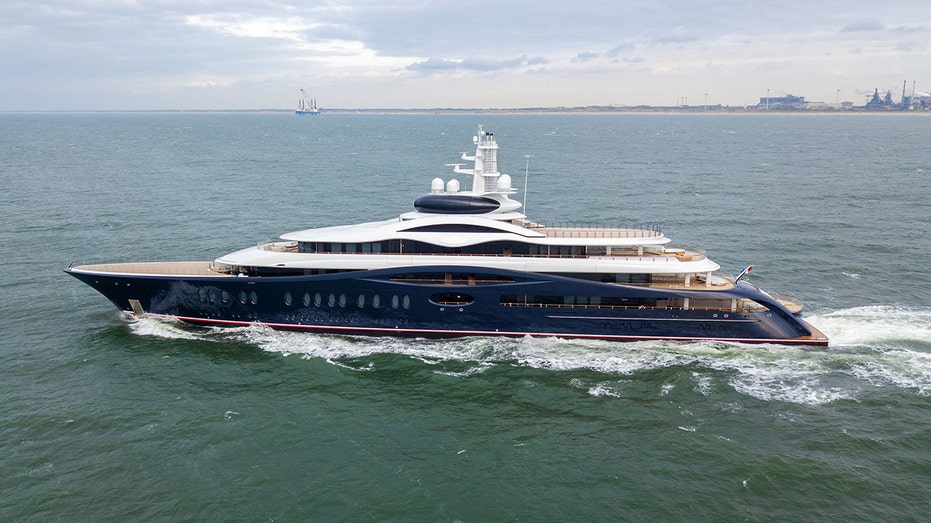
A view of the side of the Launchpad superyacht. (Dutch Yachting)
Feadship, a well-known yacht builder headquartered in the Netherlands, constructed the superyacht.
Only 70 motor yachts measuring over 100 meters currently exist, according to BOAT International. Some are believed to belong to other members of the three-comma club.
JEFF BEZOS, LAUREN SANCHEZ ENJOY SUN, SUPERYACHT
The Sun reported the 118-meter Launchpad came at a nine-figure cost.
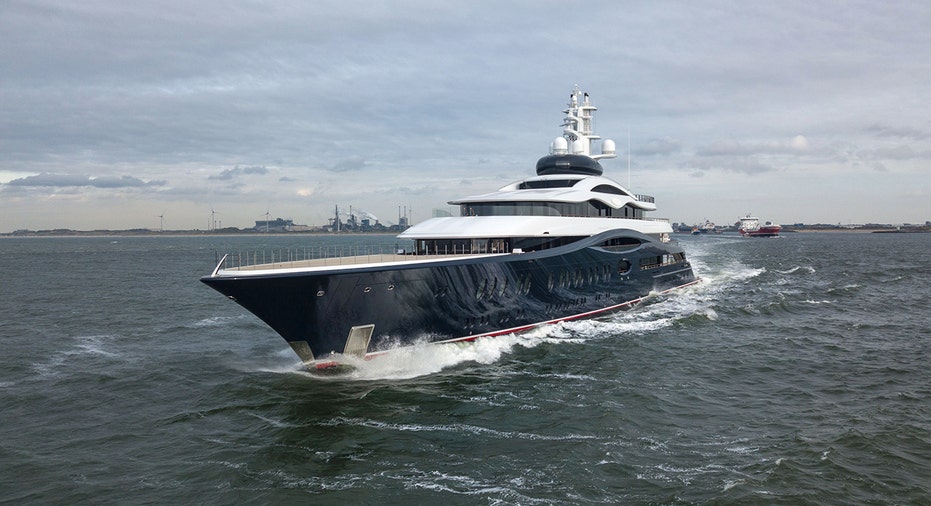
The Launchpad superyacht sailing. Credit: Dutch Yachting
Zuckerberg has amassed a personal fortune that, according to Forbes, sat around $178 billion as of Thursday evening.
He has Meta Platforms, the corporate parent of Facebook, Instagram, Whatsapp and Threads, to thank for that. He co-founded Facebook about 20 years ago.
MARK ZUCKERBERG'S HAWAII PROPERTY TO FEATURE GIANT UNDERGROUND BUNKER, TREEHOUSES: REPORT
"20 years ago I launched a thing," he wrote on the platform in early February. "Along the way, lots of amazing people joined and we built some more awesome things. We’re still at it and the best is yet to come."
He has identified artificial intelligence and the metaverse as long-term focuses of Meta Platforms.
CLICK HERE TO READ MORE ON FOX BUSINESS

More From Forbes
Despite wars and sanctions, superyacht market continues recent growth.
- Share to Facebook
- Share to Twitter
- Share to Linkedin
The Phi has been detained in Canary Wharf since March 2022.
A superyacht is a status symbol and the ultimate pleasure boat. What ordinary people envisage doing on cruise ships, the super-rich do on their mega-yachts. Space and change of scenery have appealed to humans from time immemorial. However, with luxury yacht ownership requiring vast sums of disposable income, one would think that factors putting the global economy under pressure, such as inflation, Houthi terrorists and Somali pirates attacking ships in the Red Sea, sanctions following the Russian invasion of Ukraine, and before that, the COVID-19 pandemic, would slow down the demand for superyachts. Instead, despite severe disruptions, mainly because of the post-Ukraine 2022 Russian invasion sanctions, with billions sloshing around in the global economy, demand for these vessels has reached a high point, driven by changes in the tastes of the ultra-rich, innovative new uses for superyachts, and the number of buyers able to splurge on such craft.
Expensive Mega-Toys The unique uses of a superyacht are driven by the size and crew demands that separate it from a regular yacht. A superyacht is considered to be a pleasure vessel larger than 24m (80ft) with a full-time captain and crew. This is a costly outlay. There are added costs for not including maintenance, fuel, and expensive power plant, navigation, and communications gear.
The desire for seclusion and social distancing exhibited by the rich since the 2020 pandemic lends itself perfectly to these large, customizable ships that can be taken out to sea. A fully crewed ship is also needed to keep up with for new trend in exploration and environmental sailing, with boat owners venturing outside of the Mediterranean and Caribbean to experience more varied habitats. Other luxury sectors are taking note of these trends driving demand for superyachts, with hotel chains like The Four Seasons and The Ritz-Carlton aiming to offer bespoke superyacht experiences by 2025. By introducing this option, hotel chains are responding to the increased market demand for exploration while creating an experience that is more exclusive and private than a luxury cruise.
Demand has also been driven by an expanding number of prospective superyacht buyers as the number of ultra-high-net-worth individuals continues to increase globally. The growth is primarily driven by American buyers, with significant potential in regions like China and Southeast Asia, where ultra-rich buyers with disposable income are growing at a faster pace than they are in the West. This increase in wealthy customers in Southeast Asia, combined with miles of islands and coastlines, creates the conditions for a robust scene for superyachts in the area. The emergence of a new customer base wealthy enough to purchase super- and mega-yachts has made the industry resilient in the face of government sanctions against one of the industry’s largest consumer bases: Russian oligarchs.
The megayacht Nord, believed to belong to sanctioned Russian oligarch Alexey Mordashov, is seen in ... [+] Hong Kong on Friday, Oct. 7.
Here Are All The Major Allegations Against Sean Diddy Combs
Wwe raw results winners and grades as the rock and cm punk return, its contest emerging fashion designers find support at trieste.
Target: Russia Beginning in the early 2000s, Russian billionaires developed a taste for luxury superyachts, with some like Roman Abramovich (who is reported to own 16 vessels , including the Aquamarine, Eclipse, Garcon, Halo, Pelorus, Solaris and Sussurroo), Alexei Mordashov ( Lady M and Nord ) and Eduard Khudainatov ( Scheherazade , Amadea , Crescent ) placing orders for multiple vessels. According to Superyacht News, an industry publication, Russians account for a significant piece of the world's superyacht market. Their estimated share represents about 10% of superyachts exceeding 40 meters in length. The percentage of Russian ownership rises even further for mega-yachts exceeding 80 meters, where Russians hold the number two spot globally, owning 20% of these vessels. Research by Boat International estimates the contribution of Russian buyers to the global superyacht order book (valued between €35 and €40 billion) to be €3.9 billion.
The popularity of superyachts among Russia’s wealthy has caused them to become a focus of the sanctions imposed on Russia following its invasion of Ukraine in February 2022. Alongside traditional targets, including Russian financial holdings, banks, and energy, the assets of oligarchs are actively being seized and frozen by Western powers when possible through initiatives like the Russian Elites, Proxies, and Oligarchs (REPO) task force launched by the G7 and the U.S. Treasury’s Kleptocracy Asset Recovery Rewards (KARR) program.
The seizure of superyachts as assets will likely continue through the end of the invasion of Ukraine and possibly beyond. Recently, there have been increasing calls to sell or transfer these assets, allowing Ukraine to use or sell them to compensate for the damages caused by the war.
Eclipse | 162.5m Built in 2010 , Germany
Europe Suffers Even though the superyacht industry has a sizeable consumer base in Russia, the companies building and managing these yachts are primarily based in Western Europe. Many of these boats are built by shipbuilders such as Lürssen in Germany and Heesen Yachts and Oceanco in the Netherlands. This has led one of the shipyards, Damen, to sue the Dutch government over damages it claims it suffered from the EU sanctions. Additionally, companies like Burgess in the UK, Imperial Yachts and Edmiston in Monaco, and Moran Yacht & Ship in the US, in charge of servicing, managing, and brokering superyachts, are also concentrated in the West.
While Western shipyards and management companies may lose revenue because of sanctions and asset seizure of the Russian oligarchs, keeping the yachts frozen generates additional costs for the countries where they are being held. Some Western countries devised a solution to ease the burden on taxpayers, granting owners and their representatives special licenses to pay for the frozen vessels. Notably, France and Spain have allowed the billionaire owners of at least four mega-yachts to pay for their upkeep. In the UK, the Office of Financial Sanctions Implementation (OFSI) has allowed the management company Burgess to pay for pre-sanction crew salaries of a yacht frozen in the UK.
Though the media associated superyachts with Russian oligarchs, this archetypal image of a superyacht owner may soon grow obsolete if the sanctions regime remains or even strengthens, causing multi-million dollar losses to the industry. Instead, growth in the sector is driven by a new class of rich being created in places like the United States and the Pacific Rim, seeking luxury lifestyles that can be provided by a superyacht. The superyacht industry will capitalize on the unprecedented wave of demand to increase its resilience in the stormy global security and economic environment.
Quin Buckley & Henry Tsai contributed to the production of this article.

- Editorial Standards
- Reprints & Permissions
trending now

Inside Taylor Swift and Travis Kelce's $15K-a-night Bahamas...

Eva Mendes says she and Ryan Gosling had a 'non-verbal agreement'...

Video of Sean 'Diddy' Combs with 'adopted' daughter Ava Baroni...

'Shahs of Sunset' alum Mike Shouhed's ex-fiancée sues him for...

Kate Middleton leaning on her parents for support amid cancer...

See the messy aftermath of Sean 'Diddy' Combs' homes being raided...

Sean 'Diddy' Combs' alleged drug mule arrested as feds intercept...

Taylor Swift and Travis Kelce seen kissing in bathing suits on...
- Click to share on Facebook (Opens in new window)
- Click to share on Twitter (Opens in new window)
- Click to email a link to a friend (Opens in new window)
- Click to copy URL
See Mark Zuckerberg’s glossy new $300M, 287-foot superyacht ‘Launchpad’
- View Author Archive
- Follow on Twitter
- Get author RSS feed
Thanks for contacting us. We've received your submission.
All aboard S.S. Facebook.
Mark Zuckerberg has reportedly gifted himself a $300 million megayacht, dubbed “Launchpad,” ahead of his 40th birthday.
The staggering 387-foot-long vessel was seen floating at Port Everglades in Fort Lauderdale, Fla., after arriving at its berth earlier this week, The Sun reported Thursday.

The multi-layered luxury ship’s sleek exterior was designed by Espen Øino International and boasts a steel hull and an aluminum superstructure, according to SuperYacht Times.
Reportedly ranking as the 45th largest yacht in the world, the interiors are just as aesthetically pleasing and reportedly executed by Zuretti Interior Design company, a France-based company specializing in unique and custom yacht design.
The breathtakingly beautiful floater stands out with a navy blue theme matching an American flag perched proudly on its wood-paneled stern.

There are several outdoor areas where the social media maven will be able to relax with his family and the indoor levels feature glass paneling allowing for tons of natural light.
For more Page Six you love…
- Listen to our weekly “We Hear” podcast
- Shop our exclusive merch
There also appears to be a helipad perfect for whenever the Facebook co-founder wants to travel to his vessel by air.
The Feadship-built yacht, built in 2022, can comfortably fit 24 guests aboard, requires a crew of 48, and is said to cost $30 million a year for upkeep and usage, according to Superyachtfan.com .

Want more celebrity and pop culture news?
Start your day with Page Six Daily.
Thanks for signing up!
Please provide a valid email address.
By clicking above you agree to the Terms of Use and Privacy Policy .
Want celebrity news as it breaks? Hooked on Housewives?
Boatworld insiders have been buzzing with speculation that Zuckerberg is the owner of the newly minted mega-cruise ever since it made its main voyage from the Netherlands last week.
The tech titan was spotted touring the Russian-commissioned megayacht in early March, though the impressive boat didn’t arrive stateside until this week due to sanctions, according to The Sun.
The website reported that Zuckerberg purchased the pricey yacht – along with its own $30 million partner boat — most likely as an early 40th birthday present to himself.

The boat reportedly traveled to Florida after being granted special permission to be imported just weeks ahead of Zuckerberg’s birthday on May 14.
Zuckerberg’s yacht is just 30 feet shorter than the length of fellow billionaire Jeff Bezos’ 417-foot megayacht Koru, which the Amazon boss snagged for a whopping $500 million.
Zuckerberg’s rep did not immediately respond to Page Six’s request for comment.
Share this article:

Advertisement
MORE SECTIONS
- Dear Deidre
- Visual Stories
MORE FROM THE SUN
- Newsletters
- Deliver my newspaper
- Sun Vouchers
- The Sun Digital Newspaper

World’s first ‘Transformer’ superyacht 300ft X-Kid UNFOLDS when at anchor & turns into a floating villa
- Neha Dhillon
- Published : 21:16, 23 Mar 2024
- Updated : 8:10, 26 Mar 2024
THE world's first "transformer" superyacht has been unveiled that unfolds into a floating villa when docked.
Monaco -based designer Stefano Pastrovich has finally revealed his aptly dubbed creation X-Kid Stuff, a mega superyacht designed for modern-day explorers and adventurers.

When closed, the yacht appears sleek, modern, and seamless.
Yet, when anchored you can open her up to reveal an impressive 15m of storage - purpose built for adventuring toys, jet skis , a helipad, a swimming pool, an artificial beach or even just additional sleeping space.
These detachable and self-powered units have been dubbed "floating bungalows, with the potential to become a guest-house of sorts.
This is the first concept in Pastrovich's " Parkour yacht" class, which is said to have taken inspiration from its surroundings and been as efficient as possible.
read more superyachts

Inside £1,500-an-HOUR superyacht hired by Taylor Swift before ‘pap bust-up’

Inside 'world's most eco-friendly' electric superyacht that can sail SILENTLY
The X-Kid Stuff, for example, is built in the image of a beehive.
Instead of the beams boats traditionally use, the structure of Pastrovich's revolutionary masterpiece resembles a series of hexagons.
These hexagons provide the yacht with a more fluid structure, as they can easily be moved around to recreate a new internal layout.
A spokesperson for Pastrovich Studios said: "We are looking to the future with our new categories and to a new frontier in yacht design: a single deck layout.
Most read in The Sun

I've destroyed eight marriages, and I can't stop

Plane crashes at Imperial War Museum airfield as shock photos show wreckage

Tom Clare 'had secret fling was messaging star just HOURS before Love Island'

Aerial pics show devastation after ship crash sparked bridge collapse
"Strongly influenced by land- based architecture, we have created a living space on board that transforms into a large loft-like space. The internal walls are modular and slide on rails, providing the owner and guests with the freedom to alter the internal layout as they see fit."
Pastrovich maintains that these yachts are envisioned with adaptation, the environment, and efficiency in mind.
The spokesman for the Studio continued: "At the heart of this design was the aim to create a vessel with low energy consumption, that offers the ability to explore anywhere in the world, keeps to a single deck layout, and incorporates a superior beach club."
They added that the vessels are designed to stay completely still in choppy waters, thanks to state-of-the-art stabilising technology.
Pastrovich Studio has combined the systems of self-stabilising hexapods and six hydraulic cylinders - typically found on offshore oil rigs - to keep the boat as still as possible.
The company has even added a gyroscope-based system throughout the vessel which is thought to further reduce the effect of choppy waters.
The spokesman added that every aspect of the vessel has been conceptualised with adventure in mind.
They said: "X-Kid Stuff is a true exploration vessel, designed to be capable of sailing anywhere in the world, in either hot or cold climates, capable of operating in the most adverse weather conditions.
"The vessel hosts all the equipment that a true adventure seeker would expect in its super-hangar such as RIBs, helicopters, kayaks, deep sea diving equipment and so on."
The news comes just after Mark Zuckerberg's $300 million mega yacht arrived in the US .
READ MORE SUN STORIES

Thomas the Tank Engine experience returning this year with outdoor shows & rides

I love my lopsided breasts but people think I'm mad for refusing free NHS boob job
The 287-foot-long vessel docked at Port Everglades in Fort Lauderdale, Florida, with its chrome finish reflecting a harsh sun.
It currently ranks as the 45th largest superyacht in the world.
World's biggest superyachts
Azzam - 590ft
Azzam has held the record for the world's largest privately-owned superyacht since it was constructed in 2013.
The ship cost an estimated $605m to build, and can accommodate up to 36 guests and 80 cabin crew.
Fulk Al Salamah - 538ft
Translated into 'ship of peace', Fulk Al Salamah has been in service with the Royal Navy of Oman since construction in 2016.
It became the second biggest superyacht in the world when it was built and has remained in that position.
Eclipse - 533ft
Owned by Russian billionaire Roman Abramovich, Eclipse cost an estimated $500m to build back in 2009.
At 533ft long, Eclipse was the world's biggest superyacht until Azzam was constructed four years later.
Dubai - 531ft
At just two feet shorter, Dubai is the fourth largest superyacht in the world at 531ft.
The ship was commissioned in 1995 but work was not completed until 2006 and cost an estimated $400m.
Dilbar - 512ft
The plush 512ft vessel - which has the largest indoor pool ever installed on a superyacht - is said to cost up to £60million to run every year.
The ship can accommodate up to 24 guests and 100 crew. It also has a large garden and two helipads.
Prince Abdulaziz - 482ft
Built in 1984, Prince Abdulaziz held the title of the longest and tallest yacht in the world for an impressive 22 years.
It can accommodate up to 64 guests onboard and between 60 and 65 crew.
A+ (previously Topaz) - 482ft
Previously named Topaz, A+ was built in 2012 and cost approximately $527m.
The boat is equipped with an on deck jacuzzi, two helicopter landing pads, swimming pool, tender garage, fitness hall, cinema and a large conference room.
El Mahrousa - 478ft
El Mahrousa was built in 1865 on the River Thames and held the title for world's biggest yacht for more than 100 years.
It was designed by British naval architect Oliver Lang for the Ottoman governor of Egypt .
Nord - 466ft
This mega yacht covers six decks and can accommodate up to 36 guests in its 20 cabins.
It also has two helicopter pads, a gym, elevator, swimming pool, cinema, tender garage, swimming pool, barbecue, beach club, spa room, sauna and beauty salon.
Flying Fox - 446ft
Made up of six decks, the ship can accommodate up to 36 day guests and 25 overnight guests.
The boat also features a diving centre, spa and a cryotherapy sauna.

- Billionaires
- Today's news
- Reviews and deals
- Climate change
- 2024 election
- Fall allergies
- Health news
- Mental health
- Sexual health
- Family health
- So mini ways
- Unapologetically
- Buying guides
Entertainment
- How to Watch
- My watchlist
- Stock market
- Biden economy
- Personal finance
- Stocks: most active
- Stocks: gainers
- Stocks: losers
- Trending tickers
- World indices
- US Treasury bonds
- Top mutual funds
- Highest open interest
- Highest implied volatility
- Currency converter
- Basic materials
- Communication services
- Consumer cyclical
- Consumer defensive
- Financial services
- Industrials
- Real estate
- Mutual funds
- Credit cards
- Credit card rates
- Balance transfer credit cards
- Business credit cards
- Cash back credit cards
- Rewards credit cards
- Travel credit cards
- Checking accounts
- Online checking accounts
- High-yield savings accounts
- Money market accounts
- Personal loans
- Student loans
- Car insurance
- Home buying
- Options pit
- Investment ideas
- Research reports
- Fantasy football
- Pro Pick 'Em
- College Pick 'Em
- Fantasy baseball
- Fantasy hockey
- Fantasy basketball
- Download the app
- Daily fantasy
- Scores and schedules
- GameChannel
- World Baseball Classic
- Premier League
- CONCACAF League
- Champions League
- Motorsports
- Horse racing
- Newsletters
New on Yahoo
- Privacy Dashboard
This Insane Submarine Concept Doubles as a 107-Foot Superyacht
Steve Kozloff is making his marine dream a reality.
The California-based designer, known for penning pioneering sailing yachts , trimarans , and explorers , just unveiled a new submarine concept that would allow him to fulfill his dream of traversing the deep sea with his wife, Terry.
More from Robb Report
Rossinavi Just Launched a Custom, Full-Aluminum 164-Foot Superyacht
This New 150-Foot Superyacht Can Cruise Through Shallow Waters in Florida and the Bahamas With Ease
This New 220-Foot Custom Superyacht Is Topped With an Epic Jacuzzi
Aptly christened the Deep Sea Dreamer, the 107-footer allows two or more seafarers to explore the underwater world in complete privacy. Constructed entirely of sturdy steel, the sub features massive viewing windows and a forward observation bubble that provides cinematic vistas of the surrounding ocean. It can also function as a regular yacht should you wish to explore the world above the waves.
Built for extended expeditions, the Dreamer is equipped with a hybrid diesel-electric propulsion system comprised of two Cummins engines, one electric motor, and 10 directional thrusters. During long voyages, the vessel cruises just below the waterline, with a fixed dorsal providing fresh air to the interior and the genset while expelling the exhaust. Kozloff says this submerged cruising position results in exceptional range, decent speeds, and smooth conditions. The sub has an estimated cruising speed of 6 knots, a maximum speed of 10 knots, and a go-anywhere range of 6,000 miles.
In addition, the Dreamer can dive to 328 feet and travel up to 100 miles on silent, electric power. The sub can also remain firmly planted on the ocean floor for up to seven days, with the onboard batteries providing power for the week.
Explorers will traverse the seas in the lap of luxury, too. The plush living quarters are akin to that of a superyacht. The two distinctive decks offer approximately 1,500 square feet of space for lounging and entertaining. Guests can easily travel between decks using the watertight elevator or ladder tube.
The interior includes an elegant dining area, a gourmet galley, a spacious salon, a forward lounge, a full-beam owner’s suite of 275 square feet, two guest cabins, and crew quarters. The panoramic observation salon is the highlight of the interior, with four recliners on the glass floor enabling guests to appreciate oceanic treasures. In addition, guests can enjoy nearly 2,500 square feet of space on the expansive exterior deck when the vessel is above water.
The sub remains a concept at this stage but Walt Disney once said, “If you can dream it, you can do it.”
Click here to see all the photos of the Deep Sea Dreamer.
Best of Robb Report
The 2024 Chevy C8 Corvette: Everything We Know About the Powerful Mid-Engine Beast
The World’s Best Superyacht Shipyards
The ABCs of Chartering a Yacht
Sign up for Robb Report's Newsletter . For the latest news, follow us on Facebook , Twitter , and Instagram .
Click here to read the full article.
Recommended Stories
Lakers erase 19-point, 4th-quarter deficit, outlast bucks in 2ot stunner without lebron james.
Anthony Davis, Austin Reaves and D'Angelo Russell combined to score 92 points.
Sean 'Diddy' Combs's accuser adds Cuba Gooding Jr. to sexual assault lawsuit. Everything we know.
In addition to the claims Jones has leveled against Combs, the producer claims Gooding Jr. groped and fondled him on Combs's yacht.
NFL free agency: Tre'Davious White signing with Rams and more news, updates
Follow all the developments right here with Yahoo Sports.
The top 50 people who will impact the 2024 MLB Season: Nos. 50-26
Ahead of Opening Day, here's our ranking of the characters who will help determine how the 2024 season plays out.
6 presumed dead after Francis Scott Key Bridge collapses in Baltimore: Here's what we know
Early Tuesday morning a cargo ship apparently lost power and crashed into Baltimore’s Francis Scott Key Bridge, causing it to collapse into the Patapsco River. Eight workers were on the bridge at the time of the accident — two have been rescued, while six remain missing and are presumed dead.
'No more jiggle when I laugh': These popular high-waisted undies are on sale for $4 a pop
Nearly 43,000 Amazon shoppers rave about these comfy wedgie-proof panties.
2024 NFL Draft: Which story will key teams tell, for both fantasy and reality?
Fantasy football analyst Matt Harmon breaks down how key NFL teams will shape the narrative of the 2024 draft.
Americans got 'more pessimistic' about the future of the economy in March
Consumers are feeling less confident about the future state of the US economy.
Ex-Lions CB Cameron Sutton, still wanted by police, was at team facility when arrest warrant went public
The Lions learned Sutton was wanted by Florida police when he was working out for them.
Six-pack of identical Ford Pinto Wagons for sale, in case you were looking
Six identical yellow, manual-transmission Ford Pinto Wagons are for sale on Facebook Marketplace in Hacienda Heights, California for $16,000 each.
NASA’s snake robot is designed to search out life in the icy oceans of a Saturn moon
The latter has made snake robots a compelling addition to search-and-rescue teams, as the systems can squeeze into spots people and other robots can’t. NASA JPL (Jet Propulsion Laboratory), never one to shy away from futuristic robotic applications, has been exploring ways the robust form factor could be deployed to scout out extraterrestrial life. Twenty-first-century flybys from Cassini have revealed a water-rich environment, making the ice-covered moon a potential candidate for life in our solar system.
March Madness: TV ratings tell the story — the tournament is perfect as is
Despite record television ratings, the powers that be are still talking about expanding the NCAA tournament.
No joke, this Rubbermaid 'electric toothbrush' for cleaning restored my orange grout back to white
If you want your home to dazzle, this top-seller — with more than16,000 Amazon fans — is your new best friend for spring cleaning.
With Affinity acquisition, Canva should be able to compete better with Adobe's creative tools
Canva, the high-flying Australian design and visual communication startup, announced today it was acquiring Affinity (formerly Serif), a creative tools company based in the U.K. Bloomberg reported that the deal was worth several hundred million pounds (approximately $380 million U.S.), and the company confirmed to TechCrunch that the number was accurate. Canva has typically targeted the beginner for their products, but company co-founder Cliff Obrecht sees the acquisition opening the door to more advanced users. “While our last decade at Canva has focused heavily on the 99% of knowledge workers without design training, truly empowering the world to design includes empowering professional designers too," he wrote in a blog post announcing the deal.
'My skin is tighter and softer': Grab this popular anti-aging retinol cream for $13 — that's almost 50% off
Raved a 65-year-old fan: 'I tried this lotion on one arm and did a comparison. OMG! The difference was astounding and immediate.'
Joey King says making 'We Were the Lucky Ones' was important so that people don't forget the Holocaust
“This is one of many stories from this period of time,” King told Yahoo Entertainment, “and I feel like it’s such an honor to tell this family’s story it’s so important to keep the knowledge alive.”
MLB players most likely to define the 2024 fantasy baseball season
With just a couple days left until MLB Opening Day in full, Fred Zinkie highlights nine players who could tell the story of 2024 fantasy baseball.
Adobe's Firefly Services makes over 20 new generative and creative APIs available to developers
Adobe today announced Firefly Services, a set of more than 20 new generative and creative APIs, tools and services. Firefly Services makes some of the company's AI-powered features from its Creative Cloud tools like Photoshop available to enterprise developers to speed up content creation in their custom workflows -- or create entirely new solutions. In addition, the company also today launched Custom Models, which allows businesses to fine tune Firefly models based on their assets.
Apple WWDC 2024, set for June 10-14, promises to be 'A(bsolutely) I(ncredible)'
Apple SVP Greg "Joz" Joswiak just confirmed via the social media platform formerly known as Twitter that the company's annual World Wide Developer Conference is set for June 10-14. In what is no doubt a nod to the company's artificial intelligence ambitions, the exec is promising that the event will be "Absolutely Incredible." As the name "D" in WWDC suggests, the event is heavily focused on developers for Apple's various operating systems.
Want to know how Ina Garten cooks with consistency? Her secret is this oven thermometer, and it's just $9 at Amazon
This kitchen essential lets you know your oven's true temperature for better results. How easy is that?

IMAGES
VIDEO
COMMENTS
The Top 100. A comprehensive and accurate list of the largest luxury yachts set to launch in 2024. A live list of the Top 100 largest superyachts in the world as it currently stands. The Top 100 luxury yachts launched in 2023 who defined the last year in large yachting. Has your yacht ever been in the Top 100? Search any yacht to view its ranking.
A, at 142.8 metres (468.5 ft) the largest "sail-assisted" motor yacht, as of 2018 [1] A superyacht or megayacht is a large and luxurious pleasure vessel. There are no official or agreed upon definitions for such yachts, but these terms are regularly used to describe professionally crewed motor or sailing yachts, ranging from 40 metres (130 ft ...
Read on to discover our official list of the largest, privately owned yachts in the world. 1. Azzam | 180.6m. In October 2013, Lürssen delivered the largest privately owned superyacht in the world in the form Azzam. Originally, she was designed to be 145 metres, but in the process of optimisation grew to 180 metres.
Embark on an unforgettable journey as we unveil the world's largest superyachts. Explore their incredible features, jaw-dropping designs, and the billionaire owners behind these floating palaces. Dive into the fascinating realm of ultimate luxury and grandeur on the high seas. The Top 12 of the World's Biggest Yachts and most expensive superyachts in 2023
The Infinity Yacht's support vessel, the Intrepid, is a 69-meter SeaAxe built by Amels. Owned by Eric Smidt, founder and CEO of Harbor Freight Tools, the Yacht Infinity is valued at $300 million. The yacht is among the world's largest, with a length of 117 meters and a volume of 4,978 tons. The Yacht Infinity primarily docks in Miami ...
The definitive luxury yachting portal. Yachts for sale & charter, superyacht directories, fleet, marinas, destinations, news and documentaries.
The Sailing Yacht A, initially known as Project 787 'White Pearl,' was delivered by Nobiskrug to her owner, Andrey Melnichenko, in 2017. As the world's largest sailing yacht, she measures an impressive 143 meters (469 ft) in length with a beam of 25 meters (82 ft). Featuring eight decks, SY A can accommodate 20 guests and a crew of 20.
Join me on a full tour of this INSANE Majesty 140 superyacht by Gulf Craft. This super yacht is everything you'd want in a 140 foot vessel! Some highlights o...
The Nord yacht is a 465ft motor yacht built by Lurssen. Designed by Nuvolari Lenard, its interior is a masterpiece of luxury and style. The owner of the yacht Nord is Russian billionaire Alexei Mordashov. With a top speed of 20 knots and a range of features including a helicopter hangar, swimming pool, and cinema, it offers an unparalleled ...
The yacht Dilbar is a stunning 157-meter (512 ft) superyacht, built by the renowned German shipyard Lurssen.Delivered to her owner in May 2016, she holds the title of the world's largest yacht by interior volume.Though the Azzam yacht is longer, Dilbar surpasses it in terms of overall volume and living space.. Key Takeaways: "Dilbar", one of the world's largest yachts, is owned by ...
On a cloudless morning in Viareggio, a Tuscan town that builds almost a fifth of the world's superyachts, a family of first-time owners from Tel Aviv made the final, fraught preparations. Down ...
1. Foners - 70.1 knots. The Foners is currently the fastest super yacht in the world, with a 70.1 knots top speed, keeping the first spot since its delivery back in 2000. The power behind its top speed comes from two MAN engines and three Rolls Royce gas turbines, combining together to output a whooping 21,380 hp.
Watch as I take you for a tour of one of the world's most luxurious flying fox super yachts! This amazing yacht is the perfect place to enjoy a luxurious lif...
Mar 27, 2024, 2:00 AM PDT. Jeff Bezos' superyacht Koru was the talk of the Palm Beach boat show after completing her first year at sea. Robino Salvatore/Getty Images. Jeff Bezos' yacht, which ...
World's largest portal for luxury yachts for sale and yachts for charter. Browse yachts and superyachts for sale with an extensive list of yacht brokers, v…
The yacht is a charter yacht costing €600,000 per... #superyacht #superyachts #yachts #boatsHere we do a full tour of the $65 Million Superyacht M/Y Resilience. The yacht is a charter yacht ...
995 Superyachts for Sale Worldwide. Northrop & Johnson is proud to offer an extensive, global and all-encompassing selection of superyachts for sale. The superyacht sector comprises the world's most luxurious, well-designed, top-performing yachts with a wide range of amenities and styles. We hope you find your dream yacht below.
For aspiring yacht owners looking for a luxury yacht for sale, we have put together a fine selection of luxury yachts and megayachts for sale from all over the world. Search BOAT International's collection of superyachts for sale and filter by type, length, asking price or age. Narrow the results by selecting specific features, or browse by ...
"Palm Beach is really not that far behind Miami, and Miami is the biggest in the world," Freeman said. "That was really exciting." This year's boat show features an expanded Super Yacht Show at ...
The yacht itself is revolutionary in some ways, with a 550-square-foot upper deck that can be converted into an owner's space—the owner's "enclave"—with two primary suites and a ...
Mar 19, 2024, 2:00 AM PDT. The Launchpad is a new superyacht that some say Mark Zuckerberg bought. Ruben Griffeon/SuperYacht Times. The 118-meter superyacht Launchpad made her maiden voyage last ...
But as spectacular as Launchpad sounds, super yacht fans might say it's not as spectacular as Jeff Bezos's super yacht, Koru. The $500 million sailing vessel features very tall masts, a ...
The sleek newcomer is topped with an unusually large 1,500-square-foot sundeck. Rossinavi 's newest fleet member is big on style and space. The 164-foot Bel1, which left the Italian builder's ...
Mark Zuckerberg reportedly rewarded himself with a luxurious gift: a $300 million super yacht. The billionaire Meta Platforms CEO reportedly purchased the 287-foot vessel with the name Launchpad ...
A superyacht is a status symbol and the ultimate pleasure boat. What ordinary people envisage doing on cruise ships, the super-rich do on their mega-yachts. Space and change of scenery have ...
Updated March 21, 2024, 12:04 p.m. ET. All aboard S.S. Facebook. Mark Zuckerberg has reportedly gifted himself a $300 million megayacht, dubbed "Launchpad," ahead of his 40th birthday. The ...
The HH88 is a masterful union of enhanced naval architecture, detailed design and luxurious craftsmanship. Beyond beautiful, it is destined to set new standards in the carbon catamaran world. A Super-Cat brings together the elements of luxury from the super-yacht world, then combines them with unrivaled space and performance of a Catamaran.
Built in 1984, Prince Abdulaziz held the title of the longest and tallest yacht in the world for an impressive 22 years. It can accommodate up to 64 guests onboard and between 60 and 65 crew. A+ ...
This New 150-Foot Superyacht Can Cruise Through Shallow Waters in Florida and the Bahamas With Ease. This New 220-Foot Custom Superyacht Is Topped With an Epic Jacuzzi. Aptly christened the Deep ...